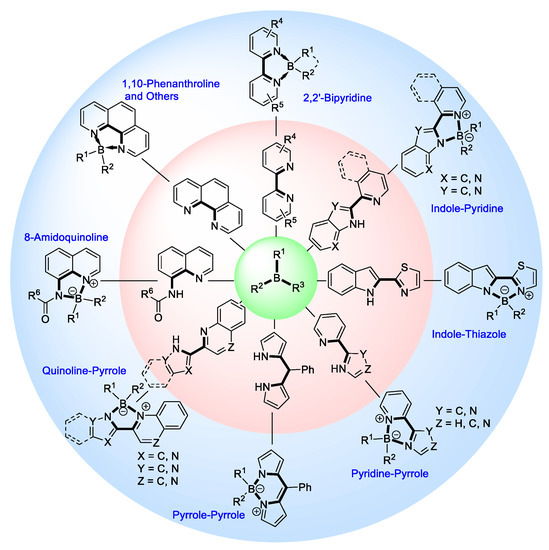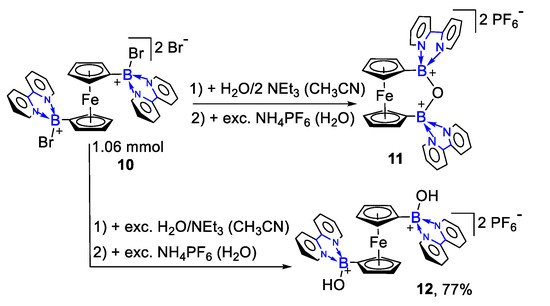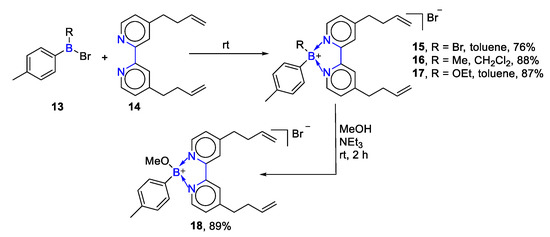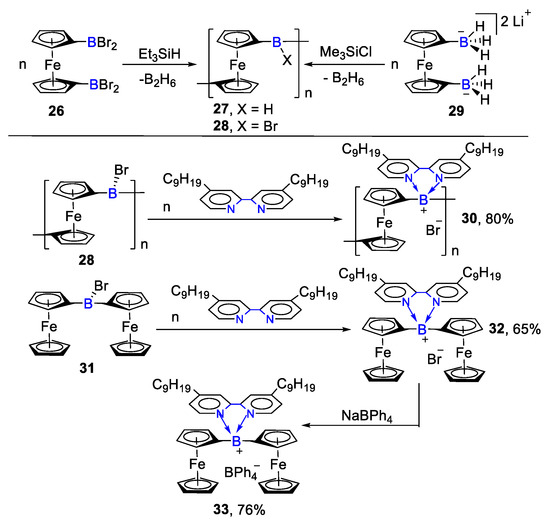N,N′-chelate organoboron compounds have been successfully applied in bioimaging, organic light-emitting diodes (OLEDs), functional polymer, photocatalyst, electroluminescent (EL) devices, and other science and technology areas. However, the concise and efficient synthetic methods become more and more significant for material science, biomedical research, or other practical science. Here, we summarized the organoboron-N,N'-chelate derivatives and showed the different routes of their synthesis. Traditional methods to synthesize N,N'-chelate organoboron compounds were mainly using bidentate ligand containing nitrogen reacting with trivalent boron reagents. In this review, we described a series of bidentate ligands, such as bipyridine, 2-(pyridin-2-yl)-1H-indole, 2-(5-methyl-1H-pyrrol-2-yl)quinoline, N-(quinolin-8-yl)acetamide, 1,10-phenanthroline, and diketopyrrolopyrrole (DPP).
- organoboron
- NN′-chelate
- tetracoordinated
- fluorescent materials
1. Introduction
N,N′-chelate tetracoordinated organoboron compounds have been widely applied in various science and technology areas. For example, boron dipyrromethene derivatives (BODIPY) were developed in luminescent materials [1][2][3][4][5][1,2,3,4,5], dyes [6][7][8][9][6,7,8,9], photosensitizers [10][11][12][13][14][10,11,12,13,14], molecular switches [15][16][17][15,16,17], photodynamic therapy [18][19][20][21][22][18,19,20,21,22], molecular probes [23][24][25][26][23,24,25,26], and bioimaging [27][28][29][27,28,29]. In recent decades, N,N′-chelate compounds become a popular topic and have gradually attracted the attention of scientists. Four-coordinated organoboron compounds (BAr2 (N, N)) have interesting luminescent properties that can be modulated by various substituents in the N, N′-chelating framework [30]. More and more similar structures were explored and exhibited wonderful results in fluorescent materials [30][31][30,31], cell bioimaging (A1) [32], organic light-emitting diodes (OLEDs) (A2) [33], functional polymer (A3) [34], photocatalyst (A8) [35], electroluminescent (EL) devices [36], and so on, as shown in Figure 1. Herein, various traditional methods for the formation of N,N′-chelate tetracoordinated organoboron complexes were exhibited in this review. The main highlights include that (a) the diversified synthetic methods were provided, (b) readily available trivalent boron compounds were used as boron reagents, (c) various complex starting materials were designed as good bidentate ligands, and (d) these reactions showed a wide range of tetracoordinated organoboron complexes and excellent optical properties.
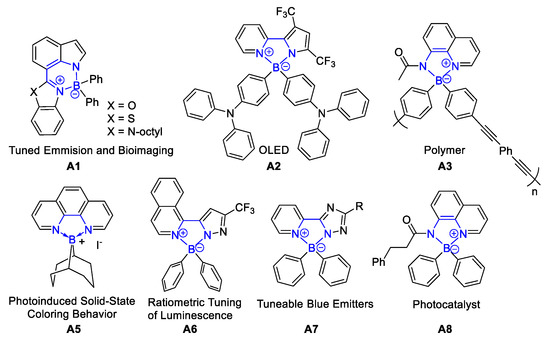
Figure 1. Application of tetracoordinate organoboron complexes in luminescent materials, organic light-emitting diode (OLED), functional polymer, and photocatalyst [30][31][32][33][34][35][36][30,31,32,33,34,35,36].
In recent years, the research on their syntheses falls into the following categories. At first, bipyridine derivatives could be used as bidentate ligand reacting with triphenylboron to form the desired products, as shown in Figure 2. The second, an indole connecting with pyridine derivatives (or other nitrogen heterocyclic molecule) reacted with triphenylboron to obtain the corresponding compounds, as shown in Figure 2. The third, pyridine attaching on pyrrole derivatives (or other nitrogen heterocyclic molecule) and trivalent boron could produce the fluorescent organoboron compounds, as shown in Figure 2. The fourth, a quinoline linking with pyrrole derivatives (or other nitrogen heterocyclic molecule) has been reported as a bidentate ligand to react with boron reagents. The different fluorescent compounds could be synthesized by N-(quinolin-8-yl)acetamide derivatives and boron reagents, as shown in Figure 2. The fifth, other bidentate ligands including 1,10-phenanthroline and diketopyrrolopyrrole (DPP) derivatives could also react with trivalent boron to obtain tetracoordinated organoboron compounds, as shown in Figure 2.
2. Bipyridine-Based Derivatives as Bidentate Ligand
In this section, different traditional methods for the formation of N,N′-chelate organoboron derivatives will be displayed in detail from the following aspects.
2.1. Bipyridine as Bidentate Ligand
In 1985, Heinrich Noeth and co-workers reported that dibutyl(((trifluoromethyl)sulfonyl)oxy)borane (1) reacted with bipyridine (2) to complete desired product. The solution of the diorganylborane should be cooled to −78 °C in this reaction. Bipyridine-dibutylboronium(1+) triflate (3) was confirmed by 11B NMR in their lab [37], as shown in Scheme 1. This protocol realized the synthesis of bipyridine coordinated organoboron complex at low temperature. It played a certain role in promoting the deep study of tetracoordinated organoboron compounds.

Scheme 1. Reactions of bipyridine with dibutyl(((trifluoromethyl)sulfonyl)oxy)borane [37].
2.2. 2,5-Di(pyridin-2-yl)pyrazine and 2′, 2′: 4′, 4′: 2″, 2‴-Quaterpyridine as Bidentate Ligand
In 2002, Matthias Wagner’s group adopted ferrocenylboranes (4) to react with 2,5-bis(pyridyl)pyrazine (5) and 2′, 2′: 4′, 4′: 2″, 2‴-quaterpyridine (6) to obtain charge-transfer complexes, respectively [38]. The organoboron adducts possess green color, which is charge transfer from the electron-rich ferrocene skeleton to their electron-poor aromatic structures, as shown in Scheme 2. This strategy provided a new route to acquire more ferrocenylborane derivatives with high yield and simple operation.
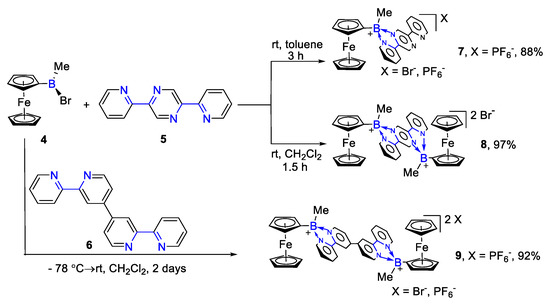
Scheme 2. Reactions of 2,5-di(pyridin-2-yl)pyrazine (or 2′, 2′: 4′, 4′: 2″, 2‴-quaterpyridine) with FcB(Me)Br [38].
2.3. Bipyridine in {Fc(Bbipy)2O}(PF6) and {Fc(Bbipy}2(OH)2}(PF6)
In 2002, Matthias Wagner’s group studied the synthesis of ferrocene complexes {Fc(Bbipy)2O}(PF6)2 (11) and {Fc(Bbipy)2(OH)2}(PF6)2 (12) [39][40][39,40], as shown in Scheme 3. They successfully synthesized tetracoordinated organoboron compounds with two boron centers. All of these compounds have the property of charge transfer. They could realize ring-closing and ring-opening products using bromide (FcMeBr) for the formation of 11 and 12 by adding different amounts of water in the reaction.
2.4. 4,4′-Di(but-3-en-1-yl)-2,2′-bipyridine as Bidentate Ligand
In 2005, Matthias Wagner’s team reported other N,N′-chelate organoboron complexes in this reaction. They used dibromo(phenyl)borane, bromo(methyl)(phenyl)borane, bromo(ethoxy)(phenyl)borane to give bipyridine adducts with satisfactory yields (15–18, 76–89%) [41], as shown in Scheme 4. This reaction indicated that different N,N′-chelate organoboron compounds could be obtained by adding distinct boron reagents under ambient temperature.
2.5. Bipyridine Reacting with 5-Chloro-5,10-dihydrodibenzo[b,e]borinine
In 2009, Warren E. Piers’s lab prepared a series of neutral radicals, which had significant spin density on boron [42]. The scaffold of 2,2′-bipyridyl-stabilized boronium ions was interesting and demonstrated bipyridine adducts persistent neutral radical. They added AgBF4 in this reaction and offered moderate yields (20–23, yield 53–77%), as shown in Scheme 5. It was proved that this protocol could easily get the target 2,2′-bipyridyl boronium ions and neutral radicals.
2.6. Bipyridine for the Formation of N,N′-Chelate Organoboron and Ferrocene Derivatives
In 2010, Matthias Wagner’s group reported a more powerful synthetic route of ferrocene complexes [43]. They used bromide (26) to obtain FcBBr polymers (27, 28) and continued to form the bipyridine organoboron polymers with main chain charge-transfer structure (30, 32, 33, 80%, 65%, 76%), as shown in Scheme 6. This method provided a new opportunity for the synthesis of multifunctional organoboron polymers.
2.7. Bipyridine Reacting with 5-Bromo-10-mesityl-5,10-dihydroboranthrene
In 2011, Matthias Wagner’s group has been committed to the development of more diversified N,N′-chelate organoboron chemistry for many years [44]. It always showed wonderful results in bipyridine organoboron adducts. They realized cleavage of the B-O-B bridge in this reaction and got the desired product with moderate yield (36, 51%), as shown in Scheme 7. In this protocol, they prepared 5-bromo-10-mesityl-5,10-dihydroboranthrene (35) as a boron reagent. This building block revealed a novel synthetic route for us.

Scheme 7. Bipyridine reacting with 5-bromo-10-mesityl-5,10-dihydroboranthrene [44].
Bipyridine reacting with 5-bromo-10-mesityl-5,10-dihydroboranthrene [44].
3. Indole-based Derivatives as Bidentate Ligand
3.1. 2-(Pyridin-2-yl)-1H-indole and 2-(pyridin-2-yl)-1H-pyrrolo [2,3-b]pyridine
Bipyridine organoboron adducts have been synthesized using various boron reagents. Except for bipyridine as bidentate ligand, indole skeleton was chosen viably. In 2000, Suning Wang’s group has synthesized and characterized blue/green luminescent materials, diphenylboron complex (38, 65%), and complex (40, 71%) [36], as shown in Scheme 8. 2-(pyridin-2-yl)-1H-indole and 2-(pyridin-2-yl)-1H-pyrrolo[2,3-b]pyridine reacted with commercially available triphenylboron to prepare the target products. The complex (40) has been developed to function as the light-emitting layer.
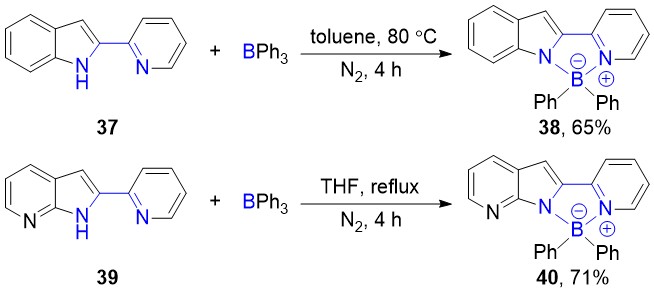 Scheme 8. Reactions of 2-(pyridin-2-yl)-1H-indole and 2-(pyridin-2-yl)-1H-pyrrolo[2,3-b]pyridine with BPh3 [36].
Scheme 8. Reactions of 2-(pyridin-2-yl)-1H-indole and 2-(pyridin-2-yl)-1H-pyrrolo[2,3-b]pyridine with BPh3 [36].
3.2. 2-(Pyridin-2-yl)-1H-Indole Derivatives Reacting with BPh3
In 2002, Suning Wang’s group explored more 5-substituted diphenylboron complexes. In this case, 5-fluoro-2-(pyridin-2-yl)-1H-indole, 5-chloro-2-(pyridin-2-yl)-1H-indole, and 5-methoxy-2-(pyridin-2-yl)-1H-indole could get desired products (42–44) [45], as shown in Scheme 9. They examined the effect of blue shift to 490 and 487 nm (42, 43, -F, -Cl) and red shift to 532 nm (44, -OCH3), respectively. They found that compound 42 could be applied in an electroluminescent device as the emitter and the electron transport material. It was inferred that different substituted groups could tune the luminescence and the property of electroluminescence of N,N'-chelate organoboron compounds.
 Scheme 9. Reactions of 2-(pyridin-2-yl)-1H-indole derivatives with BPh3 [45].
Scheme 9. Reactions of 2-(pyridin-2-yl)-1H-indole derivatives with BPh3 [45].
3.3. 2-(1H-Indol-2-yl)thiazole, 8-(1H-benzo[d]imidazol-2-yl)Quinoline and Their Derivatives
In 2005, Suning Wang’s group continued to present different indole skeleton bidentate ligands. Substituted-2-(pyridin-2-yl)-1H-indole (45), 2-(pyridin-2-yl)-1H-benzo[d]imidazole (46), 2-(1H-indol-2-yl)thiazole (47), 1-(1H-benzo[d]imidazol-2-yl)isoquinoline (48, X = C), 1-(3H-imidazo[4,5-b]pyridin-2-yl)isoquinoline (48, X = N) began with triphenylboron to generate N,N' -chelate boron complexes (49–56, 59–78%) from blue to red [30], as shown in Scheme 10. They also found that these complexes could be applied in not only emitters but also electron transport materials of electroluminescent (EL) equipment.
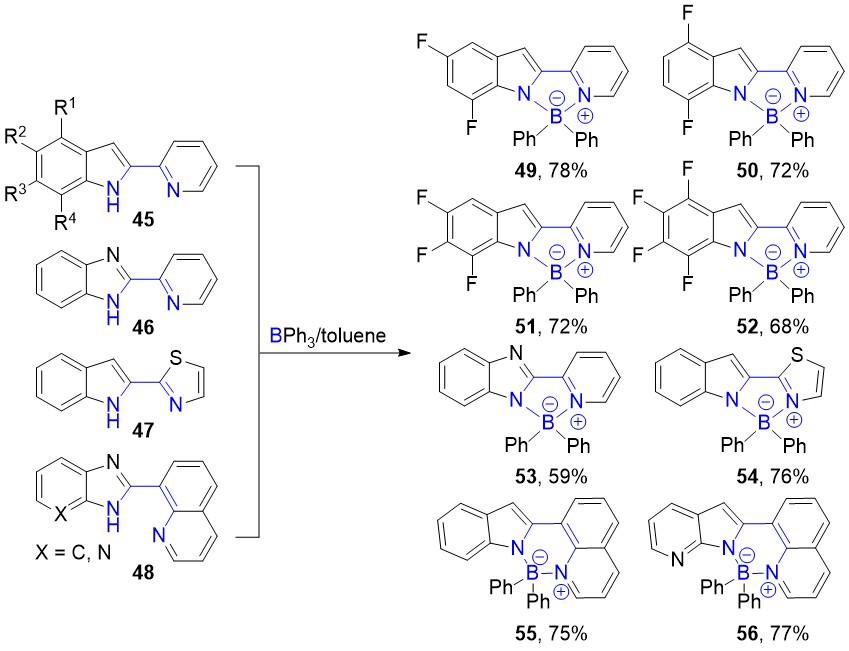 Scheme 10. Reactions of 2-(1H-indol-2-yl)thiazole, 8-(1H-benzo[d]imidazol-2-yl)quinoline, and their analogues with BPh3 [30].
Scheme 10. Reactions of 2-(1H-indol-2-yl)thiazole, 8-(1H-benzo[d]imidazol-2-yl)quinoline, and their analogues with BPh3 [30].
3.4. 2-(Pyridin-2-yl)-1H-indole Reacting with FcBMeBr
In 2005, Matthias Wagner’s group achieved reaction of ferrocene bromide and 2-(pyridin-2-yl)-1H-indole sodium to give rise to the formation of FcBMe(5-F-bipyridine) (58, 51%) and Fc2B(5-F-bipyridine) (59, 23%) in acceptable yields [46], as shown in Scheme 11. It indicated that N,N'-chelate organoboron compounds containing multiple metals could be obtained by making use of this simple protocol.
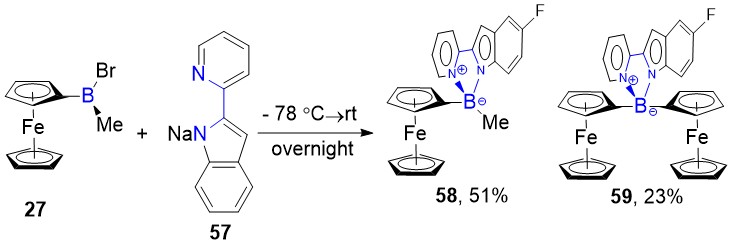 Scheme 11. Reactions of 2-(pyridin-2-yl)-1H-indole with FcBMeBr [46].
Scheme 11. Reactions of 2-(pyridin-2-yl)-1H-indole with FcBMeBr [46].
3.5. 2-(1H-Indol-7-yl)benzo[d]oxazole, 2-(1H-indol-7-yl)benzo[d]thiazole, and 2-(1H-indol-7-yl)-1-octyl-1H-benzo[d]imidazole
In 2016, David Curiel’s group described a reaction of 2-(1H-indol-7-yl)benzo[d]oxazole (60), 2-(1H-indol-7-yl)benzo[d]thiazole (61), and 2-(1H-indol-7-yl)-1-octyl-1H-benzo[d]imidazole (62) to generate organoboron complexes (63–65) with tuned emission and cell bioimaging utility [32], as shown in Scheme 12. To synthesize these diphenylboron complexes, they choose triphenylboron as boron reagent. In this paper, they succeeded in introducing more heteroatoms (S, O, N) in this building block.
 Scheme 12. Reactions of 2-(1H-indol-7-yl)benzo[d]oxazole, 2-(1H-indol-7-yl)benzo[d]thiazole, and 2-(1H-indol-7-yl)-1-octyl-1H-benzo[d]imidazole with BPh3 [32].
Scheme 12. Reactions of 2-(1H-indol-7-yl)benzo[d]oxazole, 2-(1H-indol-7-yl)benzo[d]thiazole, and 2-(1H-indol-7-yl)-1-octyl-1H-benzo[d]imidazole with BPh3 [32].
4.Pyridine-Based Derivatives as Bidentate Ligand
4.1. 2-(1H-Pyrazol-5-yl)pyridine Reacting with BPh3
In 2003, Yun Chi’s group reported a reaction of 2-(1H-pyrazol-5-yl)pyridine derivatives (67) and triphenylboron to produce pyridyl pyrazolate boron complexes (68–73, 48–90%) [47], as shown in Scheme 13, which exhibited the ability of remarkable dual fluorescence through the photoinduced electron transfer reaction. In this system, it was more efficient to synthesize the N,N'-chelate organoboron adducts in tetrahydrofuran (THF) solution for one hour. They found that electron-deficient B(C6F5)3 reagent could be also feasible in this reaction.
 Scheme 13. Reactions of 2-(1H-pyrazol-5-yl)pyridine reacting with BPh3 [47].
Scheme 13. Reactions of 2-(1H-pyrazol-5-yl)pyridine reacting with BPh3 [47].
4.2. Pyridin-2-ylmethanamine Reacting with Hydroxydiphenylborane
In 2005, Noemí Andrade-López’s group provided another method to complete the N-8-(diphenyl-hydroxy-2-aminomethylpyridine)borane (76, 95%) with high yield when added 2-pyridylmethylamine (74) and diphenylborinic acid (75) together [48], as shown in Scheme 14. In this case, they used air-stable boron reagent (diphenylborinic acid). It was proved that nonrigid bidentate ligand 2-pyridylmethylamine could also be activated.
 Scheme 14. Reactions of pyridin-2-ylmethanamine with hydroxydiphenylborane [48].
Scheme 14. Reactions of pyridin-2-ylmethanamine with hydroxydiphenylborane [48].
4.3. 2-(1H-Pyrazol-5-yl)pyridine Analogs Reacting with BPh3
In 2006, Yun Chi’s group developed 2-(1H-pyrazol-5-yl)pyridine derivatives (77) to acquire organoboron compound (78) [49], as shown in Scheme 15. It was interesting that the authors succeeded in introducing crown ether structure for detecting the alkali or alkaline earth ions.
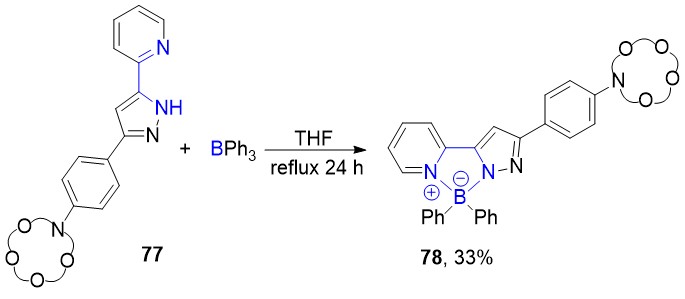 Scheme 15. Reactions of 2-(1H-pyrazol-5-yl)pyridine derivatives with BPh3 [49].
Scheme 15. Reactions of 2-(1H-pyrazol-5-yl)pyridine derivatives with BPh3 [49].
4.4. 2-(4H-1,2,4-Triazol-3-yl)pyridine Derivatives Reacting with BPh3
In 2014, Wesley R. Browne’s group showed the resulting pyridyl-1,2,4-triazole tetracoordinate organoboron complexes as available and controllable blue emitters [50]. In this system, they could only obtain the N1-bound isomer (80–83), while N3-bound isomer was not found (84), as shown in Scheme 16. It was inferred that the boron atom of triphenylboron preferred to attacking with N1 atom center. The emission quantum yield of the complex (80) was up to 0.72. Synthesized compounds displayed a great range of emissions from 397 nm to 494 nm.
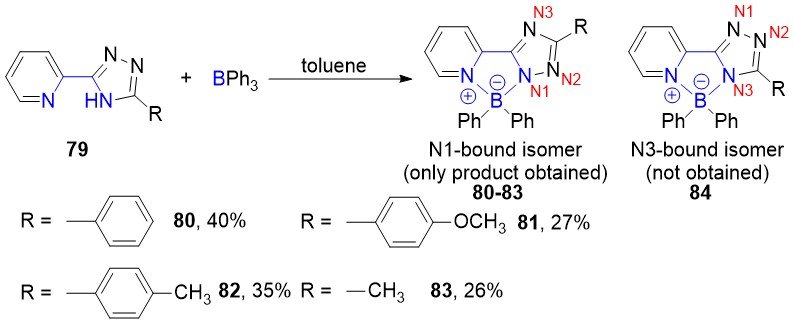 Scheme 16. Reactions of 2-(4H-1,2,4-triazol-3-yl)pyridine derivatives with BPh3 [50].
Scheme 16. Reactions of 2-(4H-1,2,4-triazol-3-yl)pyridine derivatives with BPh3 [50].
4.5. 2-(3,5-Bis(trifluoromethyl)-1H-pyrrol-2-yl)pyridine as Bidentate Ligand
In 2016, Yun Chi’s group provided a method for the synthesis of pyridyl pyrrolide boron complexes (88–90, 41–48%), which could be developed to function as organic light-emitting diodes (OLEDs) [33], as described in Scheme 17. This building block connected the electron-donating portion with the electron-accepting moieties together and succeed in generating external quantum efficiency (EQE) of 13.5%. 2-(3,5-bis(trifluoromethyl)-1H-pyrrol-2-yl)pyridine (85) and boron trichloride resulted in the intermediate compound (86, 57%). Next, it reacts with Grignard reagent (87) to give the final organoboron products (88-90). This protocol used the easy availability of Grignard reagent to produce pyridyl pyrrolide boron complexes.
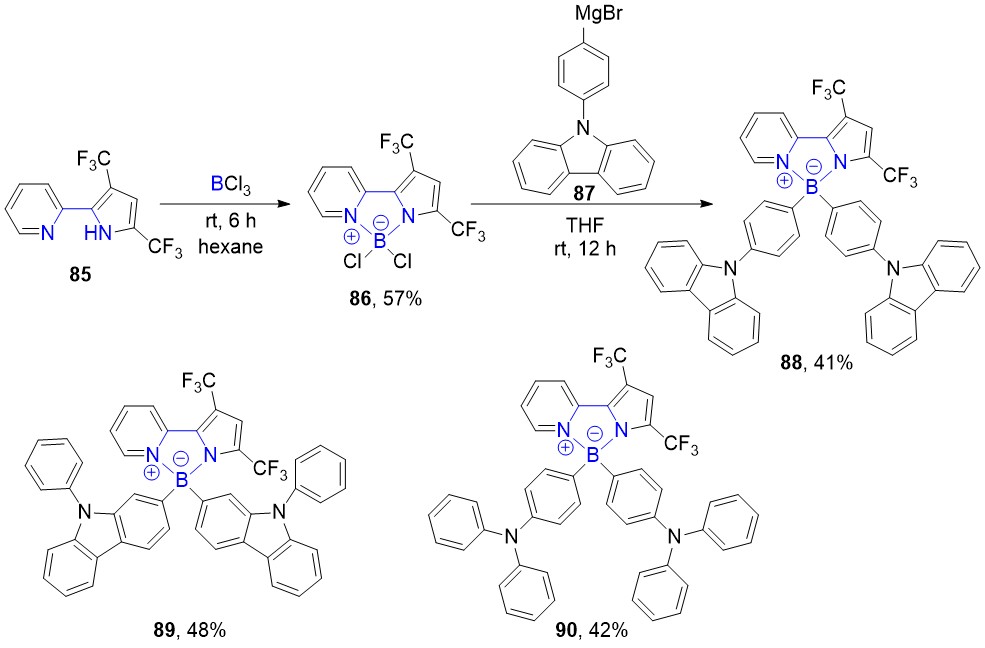 Scheme 17. Synthesis of 2-(3,5-bis(trifluoromethyl)-1H-pyrrol-2-yl)pyridine chelate organoboron complexes [33].
Scheme 17. Synthesis of 2-(3,5-bis(trifluoromethyl)-1H-pyrrol-2-yl)pyridine chelate organoboron complexes [33].
4.6. 2-(5-Methyl-1H-pyrrol-2-yl)pyridine, 2-(pyridin-2-yl)-1H-Indole, and (Z)-2-(phenyl(2H-pyrrol-2-ylidene)methyl)-1H-pyrrole as Bidentate Ligand
In 2017, Kee-In Lee’s group reported a synthetic route for the generation of N,N'-chelate organoboron complexes with mild condition and easy operation in moderate yields [51]. In this strategy, they added general phenylboronic acids to react with ligands using widely available K3PO4 to form desired products (93–96, 72–79%), as shown in Scheme 18. In this case, 2-(5-methyl-1H-pyrrol-2-yl)pyridine, 2-(pyridin-2-yl)-1H-indole, and (Z)-2-(phenyl(2H-pyrrol-2-ylidene)methyl)-1H-pyrrole could be able to respond smoothly.
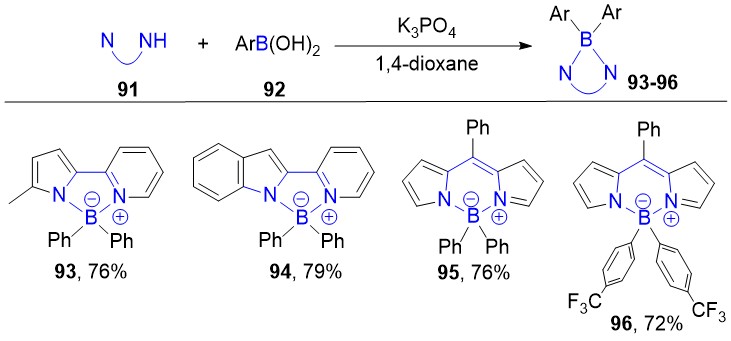 Scheme 18. Reactions of 2-(5-methyl-1H-pyrrol-2-yl)pyridine, 2-(pyridin-2-yl)-1H-indole, and (Z)-2-(phenyl(2H-pyrrol-2-ylidene)methyl)-1H-pyrrole with BPh3 [51].
Scheme 18. Reactions of 2-(5-methyl-1H-pyrrol-2-yl)pyridine, 2-(pyridin-2-yl)-1H-indole, and (Z)-2-(phenyl(2H-pyrrol-2-ylidene)methyl)-1H-pyrrole with BPh3 [51].
5.Quinoline-Based Derivatives as Bidentate Ligand
5.1. 2-(5-Methyl-1H-pyrrol-2-yl)Quinoline and 2-(5-methyl-1H-pyrrol-2-yl)Quinoxaline as Bidentate Ligand
In 2005, Chin-Ti Chen’s group exploited 2-(5-methyl-1H-pyrrol-2-yl)pyridine (97), 2-(5-methyl-1H-pyrrol-2-yl)quinoline (98), and 2-(5-methyl-1H-pyrrol-2-yl)quinoxaline (99) reacting with triphenylboron to afford diphenylboron complexes (100–102, 63–89%) [52], as shown in Scheme 19. The complexes [(pyro)BPh2] (100), [(noro)BPh2] (101), and [(xaro)BPh2] (102) exhibited emission peak maxima of strong photoluminescence at different locations such as 490 nm, 510 nm and 575 nm, respectively. The research group adopted quinoline linked with pyrrole in one molecule as bidentate ligand to react with triphenylboron.
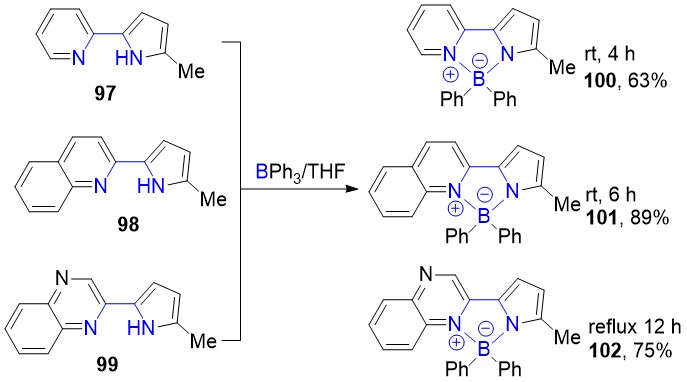 Scheme 19. Reactions of 2-(5-methyl-1H-pyrrol-2-yl)pyridine, 2-(5-methyl-1H-pyrrol-2-yl)quinoline, and 2-(5-methyl-1H-pyrrol-2-yl)quinoxaline with BPh3 [52].
Scheme 19. Reactions of 2-(5-methyl-1H-pyrrol-2-yl)pyridine, 2-(5-methyl-1H-pyrrol-2-yl)quinoline, and 2-(5-methyl-1H-pyrrol-2-yl)quinoxaline with BPh3 [52].
5.2. 2-(1H-Benzo[d]Imidazol-2-yl)Quinoline and 2-(quinolin-2-yl)-1H-naphtho[2,3-d]Imidazole Served as Bidentate Ligand
In 2006, Tsun-Ren Chen’s group realized 2-(1H-benzo[d]imidazol-2-yl)quinoline (103) and 2-(quinolin-2-yl)-1H-naphtho[2,3-d]imidazole (104) reacting with triphenylboron to generate diphenylboron complexes (105-106, 30–35%) [53], as shown in Scheme 20. The product (105) could be used as organometallic emitting material in organic light-emitting diodes (OLEDs). They succeeded in the synthesis of target organoboron products and adopted them (105, 106) as the emitting materials of electroluminescence (EL) device. It was demonstrated that tetracoordinated organoboron complexes could be selected as organic light-emitting diodes (OLEDs) as well.
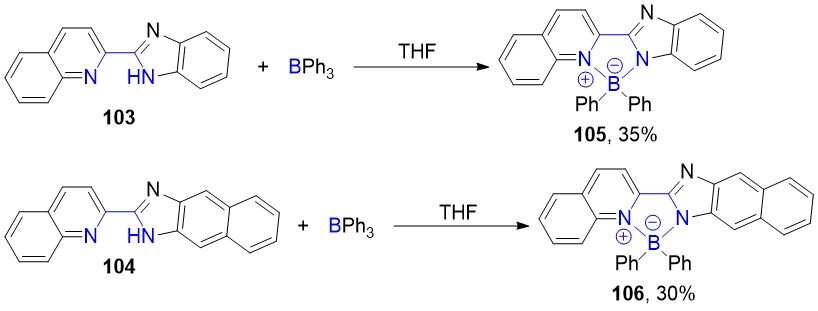 Scheme 20. Synthesis of BPh2(2-(2-quinolyl)naphtho[b]imidazolato) and BPh2(2-(2-quinolyl)benzimidazolato) [53].
Scheme 20. Synthesis of BPh2(2-(2-quinolyl)naphtho[b]imidazolato) and BPh2(2-(2-quinolyl)benzimidazolato) [53].
5.3. 1-(3-(Trifluoromethyl)-1H-pyrazol-5-yl)Isoquinoline as Bidentate Ligand
Recently, in 2019, Pi-Tai Chou’s group designed and synthesized 1-isoquinolinyl pyrazolate biphenylboron complexes [54]. 1-(3-(trifluoromethyl)-1H-pyrazol-5-yl)isoquinoline was used to react with various boron reagents (BPh3, BCl3, 9-bromo-9-borafluorene, or 10-bromo-9-oxa-10-boraanthracene) to afford desired products (107–111), as shown in Scheme 21. The authors measured the time-resolved fluorescence and studied theoretical calculation, then found these complexes having the phenomenon of photoinduced electron transfer (PET) from the locally excited (LE) (over the isoquinolinyl pyrazolate moiety) to charge transfer (CT) states (from isoquinolinyl to aryl appendages).
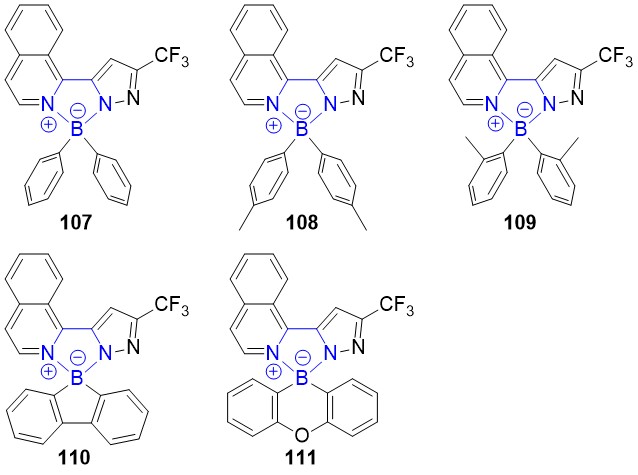 Scheme 21. Synthesis of 1-(3-(trifluoromethyl)-1H-pyrazol-5-yl)isoquinoline chelate organoboron complexes [54].
Scheme 21. Synthesis of 1-(3-(trifluoromethyl)-1H-pyrazol-5-yl)isoquinoline chelate organoboron complexes [54].
5.4. N-(Quinolin-8-yl)Acetamide as Bidentate Ligand
In 2008, Yoshiki Chujo’s group prepared N,N′-chelate tetracoordinated organoboron polymers by Sonogashira-Hagihara cross-coupling reaction [34]. They reported a reaction of N-(quinolin-8-yl)acetamide (112) and triphenylboron (43%), as shown in Scheme 22. The research group used tri(4-iodinephenyl)boron to synthesize the monomer (114, 53%). It continued to react with alkynes to obtain the final polymers (115–117, 40–51%). This paper showed that the π-conjugated linker unit had a great influence on the fluorescent quantum efficiencies of the synthesized polymers. Besides, they also observed an obvious energy transfer.
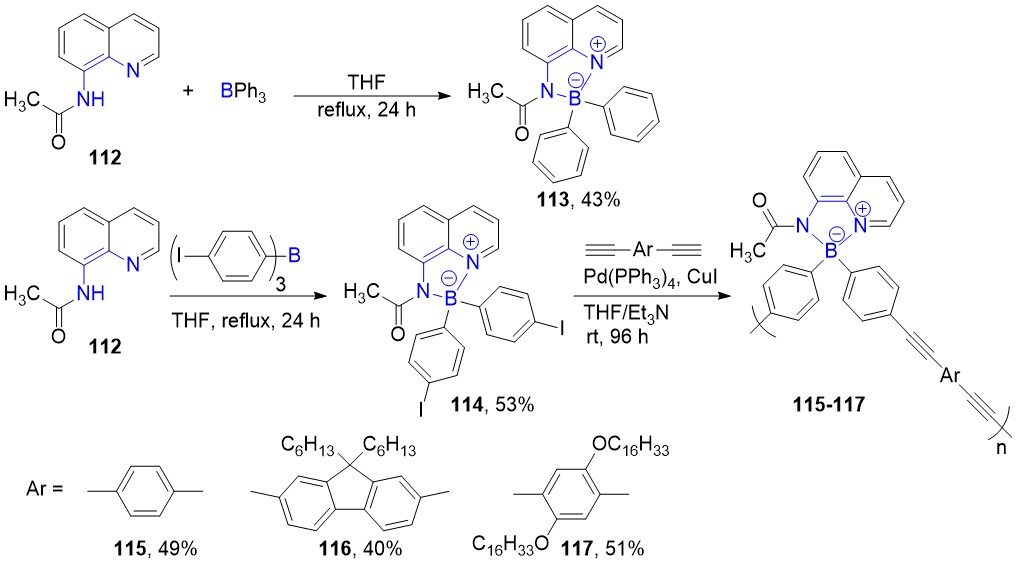 Scheme 22. Reactions of N-(quinolin-8-yl)acetamide with BPh3 [34].
Scheme 22. Reactions of N-(quinolin-8-yl)acetamide with BPh3 [34].
5.5. (S)-N-(1-((5-iodoquinolin-8-yl)amino)-1-oxopropan-2-yl)hexanamide as Bidentate Ligand
In 2010, Yoshiki Chujo’s group used (S)-N-(1-((5-iodoquinolin-8-yl)amino)-1-oxopropan-2-yl)hexanamide (118) and diphenyl with two boronbromide centers resulting in organoboron monomer (120, 24%) [55], as shown in Scheme 23. They chose palladium-catalyzed Sonogashira coupling between iodide (120) and bis-alkyne to prepare luminescent chiral four-coordination organoboron quinoline-based polymers. It was interesting to see that the quantum yield (ΦF) of the synthesized polymer (122) was up to 0.8.
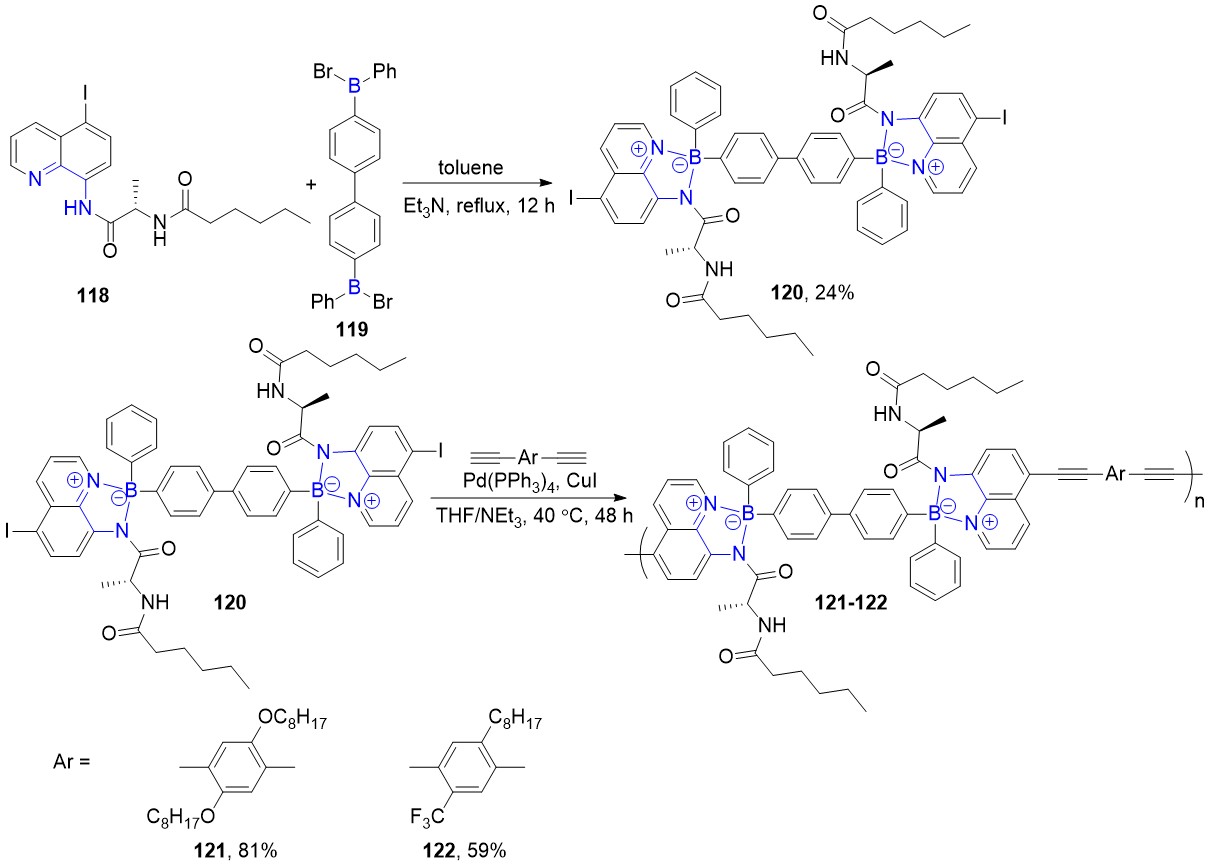 Scheme 23. Synthesis of (S)-N-(1-((5-iodoquinolin-8-yl)amino)-1-oxopropan-2-yl)hexanamide chelate organoboron polymer [55].
Scheme 23. Synthesis of (S)-N-(1-((5-iodoquinolin-8-yl)amino)-1-oxopropan-2-yl)hexanamide chelate organoboron polymer [55].
5.6. N-(5-Iodoquinolin-8-yl)Undecanamide as Bidentate Ligand
In 2010, Yoshiki Chujo’s group developed strong luminescent organoboron polymers connected with bifunctional 8-aminoquinolate linkers [56]. They used N-(5-iodoquinolin-8-yl)undecanamide and bis-alkyne resulting in corresponding polymers (124–127) by Sonogashira-Hagihara cross-coupling reaction, as shown in Scheme 24. In this case, they introduced long alkyl chains and various aryl groups and finally found the organoboron polymer (127, Ar1 = P, Ar2 = F, 85%) (ΦF = 0.65) achieving a higher quantum yield than others. Compared with (S)-N-(1-((5-iodoquinolin-8-yl)amino)-1-oxopropan-2-yl)hexanamide as starting material to obtain N,N'-chelate organoboron complexes, N-(5-iodoquinolin-8-yl)undecanamide as bidentate ligand showed different optical properties. It indicated that the fluorescent characteristic of organoboron polymers could be changed by different substituted portions.
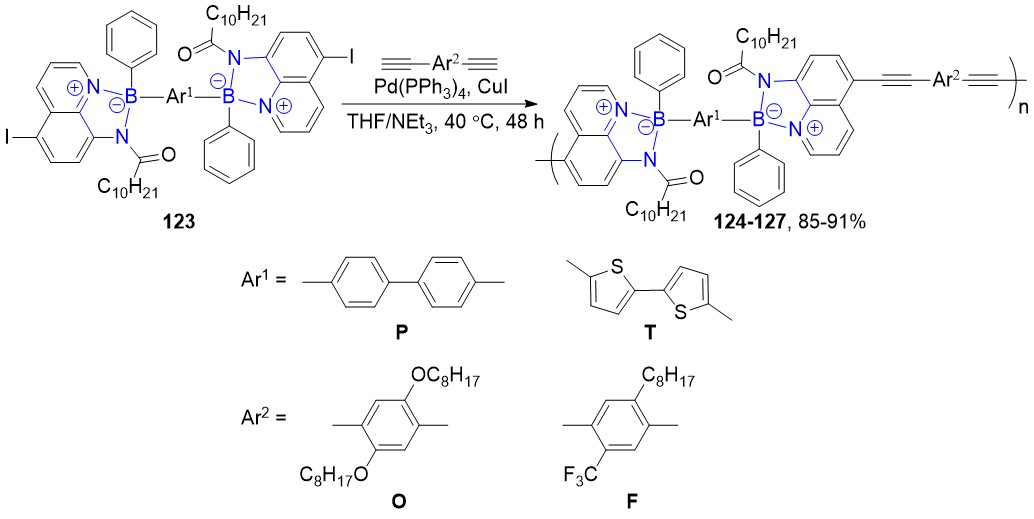 Scheme 24. Synthesis of N-(5-iodoquinolin-8-yl)undecanamide chelate organoboron polymer [56].
Scheme 24. Synthesis of N-(5-iodoquinolin-8-yl)undecanamide chelate organoboron polymer [56].
5.7. N-(quinolin-8-yl)acetamide as Bidentate Ligand
Two years later, in 2012, Yoshiki Chujo’s group designed and synthesized 8-aminoquinolate-based organoboron polymers with rigid structure, which had electron-donating and electron-accepting structure in the basic skeleton [57]. In order to get the corresponding starting material, they added tin compound (128) and boron tribromide to give the intermediate (130) in two steps, as shown in Scheme 25. Next, it continued to react with N-(quinolin-8-yl)acetamide to afford adduct monomer in acceptable yield (131, 34%). Final 8-aminoquinolate-based organoboron products were prepared by classical Sonogashira-Hagihara cross-coupling reaction (132, 133, 84%, 84%). The quantum yield of polymer (132) was up to 0.53. It was certain that this scaffold with 8-aminoquinolate-based could achieve more efficient luminescent properties by introducing the -C8F17 group.
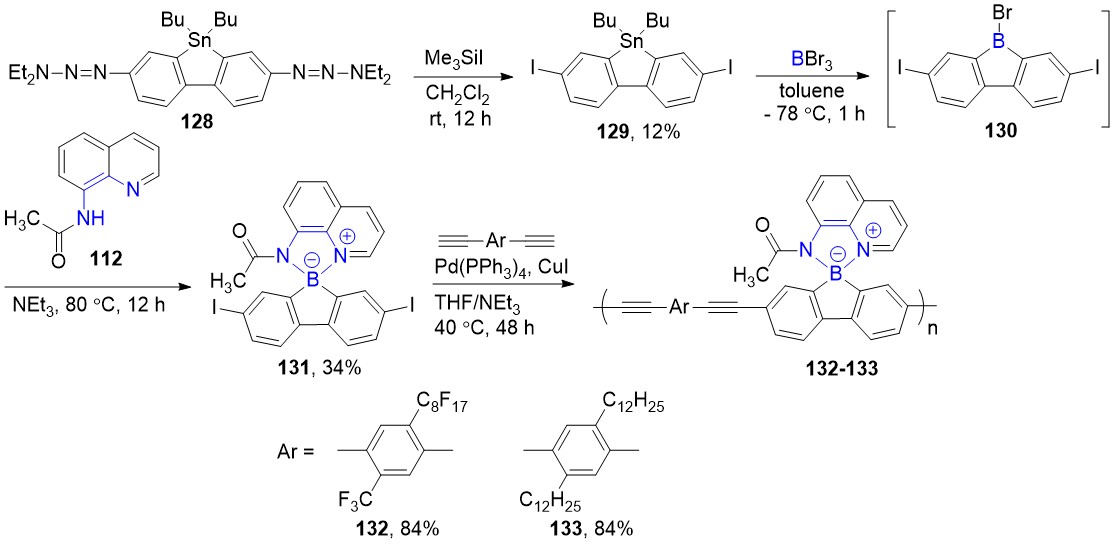 Scheme 25. Synthesis of N-(quinolin-8-yl)acetamide chelate organoboron polymer [57].
Scheme 25. Synthesis of N-(quinolin-8-yl)acetamide chelate organoboron polymer [57].
5.8. Quinolin-8-amine as Bidentate Ligand
In 2012, Douglas W. Stephan’s group reported a reaction of readily available quinoline-8-amine (134) and electron-deficient B(C6F5)2H [58]. Biperfluorophenylboron complex was synthesized in moderate yield (135, 76%) without any catalyst, as shown in Scheme 26. The result indicated that tetracoordinated organoboron compounds could also be successfully obtained from primary amines.
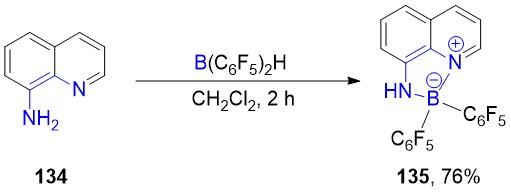 Scheme 26. Synthesis of quinolin-8-amine chelate organoboron complex [58].
Scheme 26. Synthesis of quinolin-8-amine chelate organoboron complex [58].
5.9. 3-Phenyl-N-(quinolin-8-yl)Propanamide Derivatives as Bidentate Ligand
In 2020, Xu’s group designed and synthesized a series of 3-phenyl-N-(quinolin-8-yl)propanamide-based organoboron complexes as photocatalysts [35]. At first, they prepared starting materials 3-phenyl-N-(quinolin-8-yl)propanamide derivatives (136) that were added in Mn/p-tosyl chloride/Na2CO3 system. Desired 3-phenyl-N-(quinolin-8-yl)propanamide-based organoboron complexes were acquired with high yields (138–144, 80–96%), as shown in Scheme 27. In this case, they added cheap transitional metal manganese powder. It was worth noting that they used widely available and air-stable boron reagents (Ar-BF3K, 137). This protocol provided a useful path for the generation of aminoquinolate-based organoboron complexes efficiently.
 Scheme 27. Synthesis of 3-phenyl-N-(quinolin-8-yl)propanamide derivatives chelate organoboron photocatalysts [35].
Scheme 27. Synthesis of 3-phenyl-N-(quinolin-8-yl)propanamide derivatives chelate organoboron photocatalysts [35].
5.10. 2,2,2-. Trifluoro-N-(quinolin-8-yl)acetamide Derivatives as Bidentate Ligand
In 2020, our group almost at the same time reported the reaction of 2,2,2-trifluoro-N-(quinolin-8-yl)acetamide derivatives (145) and sodium tetraarylborate, resulting in aminoquinolate-based organoboron complexes (146–168) with high yields using iodine as catalyst [31], as depicted in Scheme 28. We made a modification from 2,2,2-trifluoro-N-(quinolin-8-yl)acetamide with various functional groups. In our protocol, we synthesized successfully a series of cheap and air-stable sodium tetraarylborates. Only a catalytic amount of iodine was enough to drive this reaction. In addition, we showed that adding external acids in this system formed the novel N,N'-chelate organoboron aminoquinolate with moderate yields (159–168, 45–89%). All the complexes were fully characterized and we found that the quantum yield of organoboron compound (146) reached 0.79 when dissolved in dichloromethane.
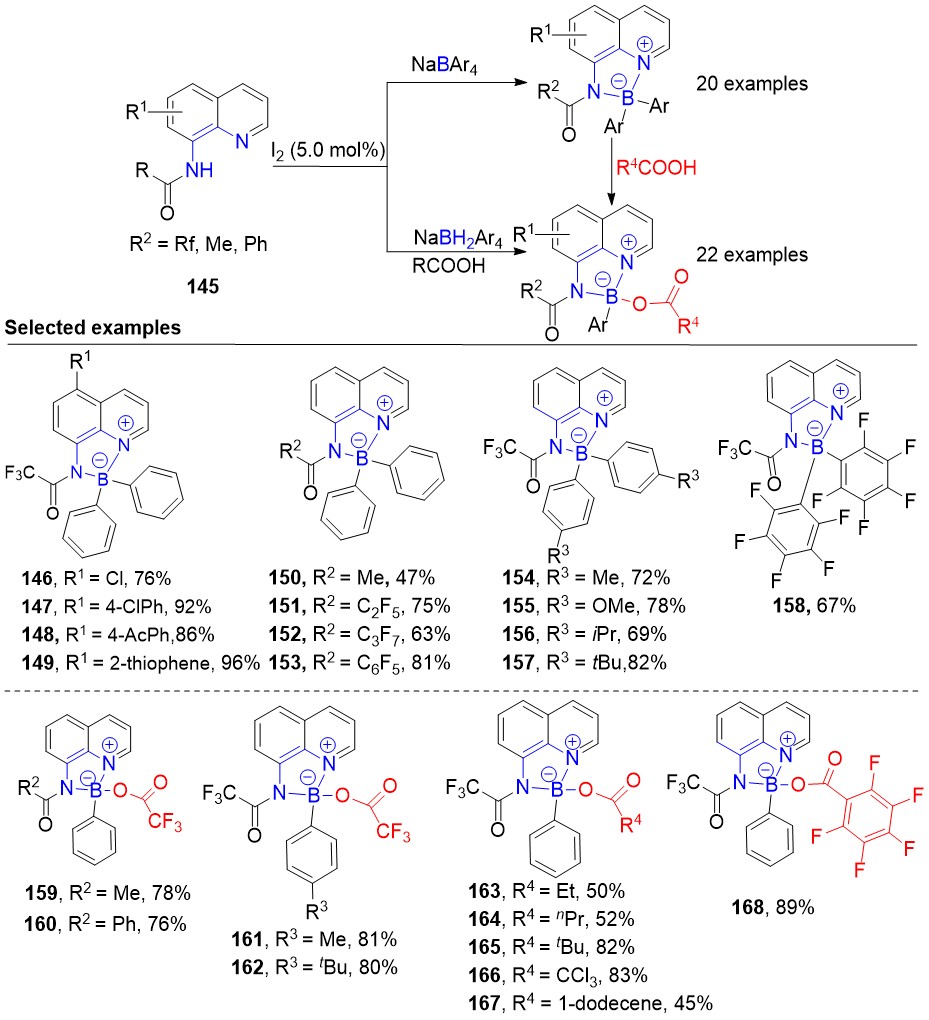 Scheme 28. Synthesis of 2,2,2-trifluoro-N-(quinolin-8-yl)acetamide-based organoboron fluorescent complexes [31].
Scheme 28. Synthesis of 2,2,2-trifluoro-N-(quinolin-8-yl)acetamide-based organoboron fluorescent complexes [31].
6.1,10-Phenanthroline and Others as Bidentate Ligand
6.1. 1,10-. Phenanthroline as Bidentate Ligand
In 2013, Douglas W. Stephan’s group treated 1,10-phenanthroline with the same amount of the boron reagent B(C6F5)3 to afford the desired salt (170, 73%) under H2 (4 atm) condition [59], as shown in Scheme 29. The authors tried to develop an organoboron catalyst, which has the ability of frustrated Lewis pairs (FLPs) catalyst in practical applications. In this paper, they developed a new synthetic route of tetracoordinated organoboron complexes by using 1,10-phenanthroline.
 Scheme 29. Synthesis of 1,10-phenanthroline chelate organoboron complex [59].
Scheme 29. Synthesis of 1,10-phenanthroline chelate organoboron complex [59].
6.2. 1,10-. Phenanthroline as Bidentate Ligand
In 2016, Hiroyuki Higuchi’s group also reported 1,10-phenanthroline as bidentate ligand to react with 9-borabicyclo[3.3.1]nonan-9-yl trifluoromethanesulfonate to obtain the organoboron complex (172, 30%) [60], as shown in Scheme 30. Next, it was reacted with potassium iodide solution to afford the corresponding salt (173, 13%). It was noteworthy that the synthesized complex (173) displayed photoinduced different color behavior in the solid-state after UV irradiation.
 Scheme 30. Synthesis of 1,10-phenanthroline chelate organoboron complex [60].
Scheme 30. Synthesis of 1,10-phenanthroline chelate organoboron complex [60].
6.3. (9. E,10E)-N9,N10-bis(6-methylheptyl)phenanthrene-9,10-Diimine as Bitentate Ligand
In 2017, Douglas W. Stephan’s group described an original synthetic strategy to give rise to (9E,10E)-N9,N10-bis(6-methylheptyl)phenanthrene-9,10-diimine-based organoboron complex (177), but only found the radical (177) measured by DART-MS and electron paramagnetic resonance (EPR) signal [61], as shown in Scheme 31. They continued to improve and develop previous work and used HB(C6F5)2 reagent to react with bidentate ligand (174) to prepare frustrated Lewis pairs (FLPs) catalyst in this paper.
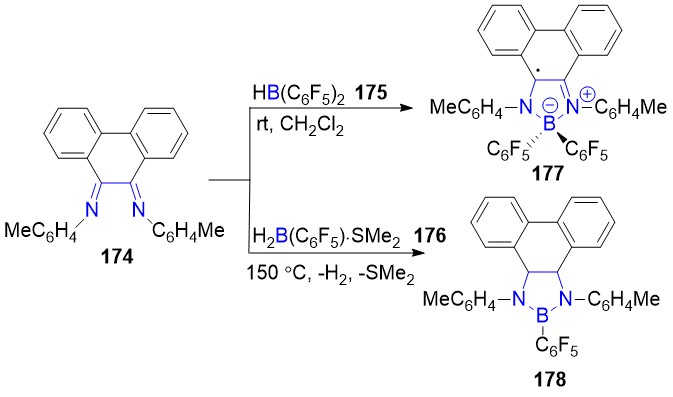 Scheme 31. Reactions of (9E,10E)-N9,N10-bis(6-methylheptyl)phenanthrene-9,10-diimine with trivalent boron [61].
Scheme 31. Reactions of (9E,10E)-N9,N10-bis(6-methylheptyl)phenanthrene-9,10-diimine with trivalent boron [61].
6.4. Diketopyrrolopyrrole (DPP) Derivatives as Bitentate Ligand
In 2014, Takaki Kanbara and co-workers disclosed a route for the generation of diketopyrrolopyrrole (DPP)-based diphenylboron complexes with moderate yields (184–186, 21–71%) [62], as shown in Scheme 32. In this case, diketopyrrolopyrrole derivatives were synthesized by using 5-substituted-picolinonitrile (179) and dibutyl succinate (180). Next, triphenylboron reacted with them to form the diphenylboron complexes (184–186). At last, the authors studied the corresponding theoretical calculation in their work, which indicated that the introduction of the coordinating boron element could lower the band gap.
 Scheme 32. Synthesis of boron-coordinated diketopyrrolopyrrole (DPP) derivatives [62].
Scheme 32. Synthesis of boron-coordinated diketopyrrolopyrrole (DPP) derivatives [62].
6.5. Diketopyrrolopyrrole (DPP) Derivatives as Bitentate Ligand
In 2014, Takaki Kanbara and co-workers continued to improve this scaffold by introducing phenylacetylene derivatives [63], by palladium-catalyzed Sonogashira coupling. Synthesized diketopyrrolopyrrole-based diphenylboron complexes (187–188) showed red-shift of the location of wavelengths to a near-infrared region, as shown in Scheme 33. This was a good strategy to extend π-conjugation of diketopyrrolopyrrole-based diphenylboron complexes by linking with more rigid phenylethynyl groups, which reached red-shift in near-infrared region and achieved high quantum yields.
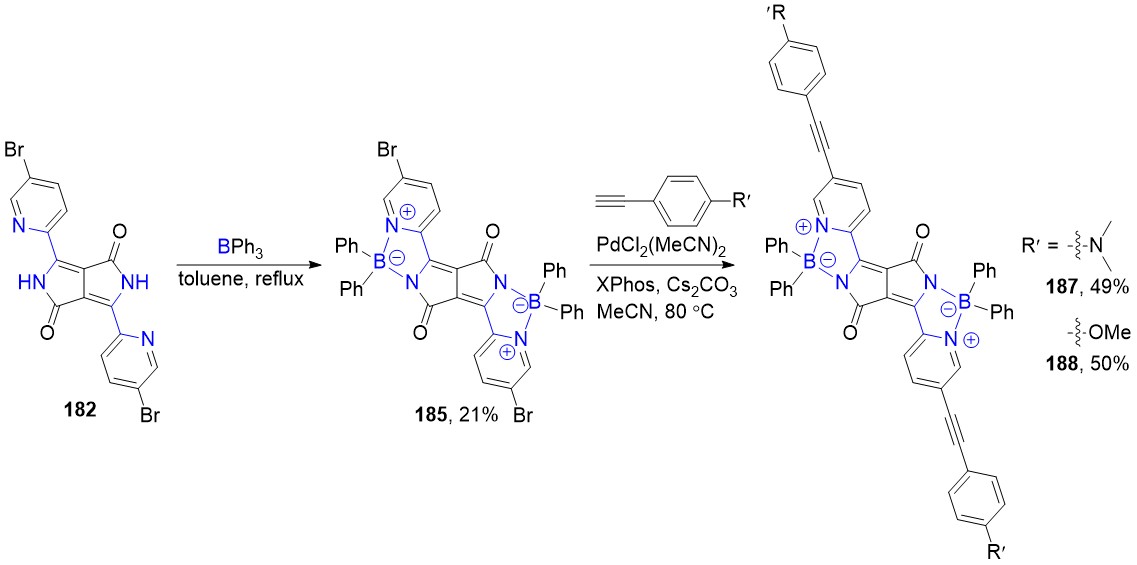 Scheme 33. Synthesis of boron-coordinated diketopyrrolopyrrole (DPP) derivatives [63].
Scheme 33. Synthesis of boron-coordinated diketopyrrolopyrrole (DPP) derivatives [63].
6.6. Reactivity of 1,2,3,4,5-pentaphenyl-1H-borole with Isocyanates
In 2016, Caleb D. Martin’s group used 1,2,3,4,5-pentaphenyl-1H-borole (189) with isocyanates to generate a seven-membered ring (194) and it continued to react with another isocyanate to afford more complex organoboron products (195, 196, 74%, 77%, respectively) [64], as shown in Scheme 34. The boron atom of the complex (191) would attack the nitrogen atom in the presence of pyridine to form a new adduct (192, 95%).
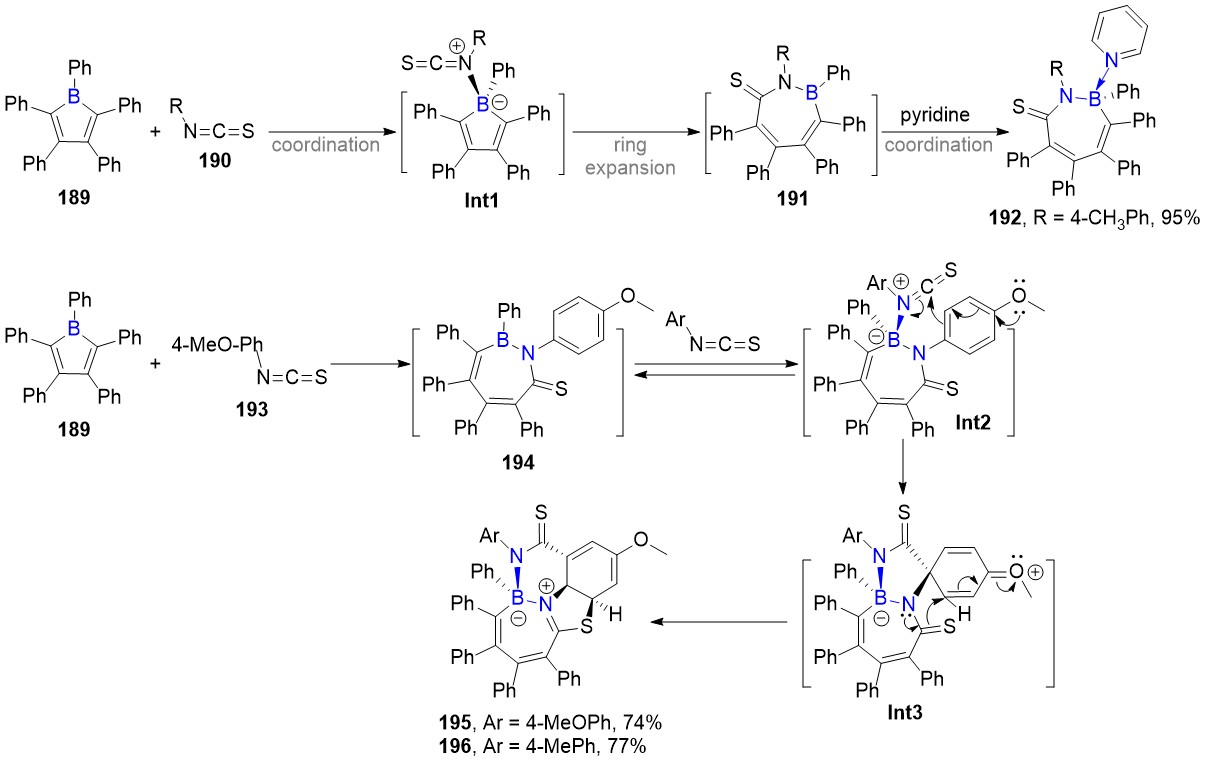 Scheme 34. Reactions of 1,2,3,4,5-pentaphenyl-1H-borole with isocyanates [64].
Scheme 34. Reactions of 1,2,3,4,5-pentaphenyl-1H-borole with isocyanates [64].
7.Conclusions and outlook
In summary, tetracoordinated organoboron compounds have been widely applied in cell imaging, organic light-emitting diodes (OLEDs), functional polymer, photocatalyst, electroluminescent (EL) devices, and other science and technology areas. N,N'-chelate diarylboron complexes have been successfully synthesized by using a series of bidentate ligands and diversified boron reagents. Bidentate ligands mainly consist of two parts by using bipyridine, indole, pyrrole, quinoline, isoquinoline, pyridine, 1H-benzo[d]imidazole, and others. The boron reagents mainly include triphenylboron, boron trichloride, boron tribromide, B(C6F5)3, HB(C6F5)2, hydroxydiphenylborane (Ph2BOH), phenylboronic acids, sodium tetraaylborate, and FcMeBr in this review. However, there is main focus including exploring wider substrates as bidentate ligand, more diversified boron reagents, simpler and greener reaction condition, and higher yields. Besides, this N,N¢-chelate organoboron framework should be developed in these fields such as molecular probes, cell imaging, fluorescent dyes, OLEDs, and so on. We expect with continuous effort more efficient and greener methods for exploiting more powerful diphenylboron complexes.
Author Contributions: Conceptualization, Q.W. and R.Q.; writing—original draft preparation, T.Y., N.T., Q.W., and R.Q.; writing—review and editing, T.Y., S.-F.Y., Q.W., and R.Q.; visualization, S.-F.Y. and R.Q.; supervision, R.Q.; project administration, Q.W. and R.Q. All authors have read and agreed to the published version of the manuscript.
Funding: The authors thank the Natural Science Foundation of China (21878071, and 21971060), Natural Science Foundation of Changsha (kq2004008), Hu-Xiang High Talent in Hunan Province (2018RS3042), and the Recruitment Program of China (WQ20164300353) for financial support.
Board Statement: “Not applicable” for studies not involving humans or animals.
Informed Consent Statement: “Not applicable” for studies not involving humans.
Data Availability Statement: The data presented in this study are openly available in references (1-64).
Acknowledgments: The authors thank Nobuaki Kambe (Osaka University), Wai-Yeung Wong (The Hong Kong Polytechnic University), and Chak-Tong Au (Hong Kong Baptist University) for helpful discussion.
Conflicts of Interest: The authors declare no conflict of interest.
References
- Maeda, C.; Nagahata, K.; Shirakawa, T.; Ema, T. Azahelicene-Fused BODIPY Analogues Showing Circularly Polarized Lu-minescence. Angew. Chem. Int. Ed. Engl. 2020, 59, 1–6.Kexuan Huang; Caleb D. Martin; Peculiar Reactivity of Isothiocyanates with Pentaphenylborole. Inorganic Chemistry 2015, 55, 330-337, 10.1021/acs.inorgchem.5b02469.
- Chi, W.; Chen, J.; Liu, W.; Wang, C.; Qi, Q.; Qiao, Q.; Tan, T.M.; Xiong, K.; Liu, X.; Kang, K.; et al. A General Descriptor DeltaE Enables the Quantitative Development of Luminescent Materials Based on Photoinduced Electron Transfer. J. Am. Chem. Soc. 2020, 142, 6777–6785.Weijie Chi; Jie Chen; Wenjuan Liu; Chao Wang; Qingkai Qi; Qinglong Qiao; Tee Meng Tan; Kangming Xiong; Xiao Liu; Keegan Kang; et al.Young-Tae ChangZhaochao XuXiaogang Liu A General Descriptor ΔE Enables the Quantitative Development of Luminescent Materials Based on Photoinduced Electron Transfer. Journal of the American Chemical Society 2020, 142, 6777-6785, 10.1021/jacs.0c01473.
- Gartzia-Rivero, L.; Ray Leiva, C.; Sanchez-Carnerero, E.M.; Banuelos, J.; Moreno, F.; Maroto, B.L.; Garcia-Moreno, I.; Infan-tes, L.; Mendez, B.; Lopez-Arbeloa, I.; et al. Chiral Microneedles from an Achiral Bis(boron dipyrromethene): Spontaneous Mirror Symmetry Breaking Leading to a Promising Photoluminescent Organic Material. Langmuir 2019, 35, 5021–5028.Leire Gartzia-Rivero; Cesar Ray Leiva; Esther M. Sánchez-Carnerero; Jorge Bañuelos; Florencio Moreno; Beatriz L. Maroto; Inmaculada García-Moreno; Lourdes Infantes; Bianchi Mendez; Iñigo Lopez-Arbeloa; et al.Santiago De La Moya Chiral Microneedles from an Achiral Bis(boron dipyrromethene): Spontaneous Mirror Symmetry Breaking Leading to a Promising Photoluminescent Organic Material. Langmuir 2019, 35, 5021-5028, 10.1021/acs.langmuir.9b00409.
- Tian, D.; Qi, F.; Ma, H.L.; Wang, X.Q.; Pan, Y.; Chen, R.F.; Shen, Z.; Liu, Z.P.; Huang, L.; Huang, W. Domino-like mul-ti-emissions across red and near infrared from solid-state 2-/2,6-aryl substituted BODIPY dyes. Nat. Commun. 2018, 9, 2688.Dan Tian; Fen Qi; Huili Ma; Xiaoqing Wang; Yue Pan; Runfeng Chen; Zhen Shen; Zhipeng Liu; Ling Huang; Wei Huang; et al. Domino-like multi-emissions across red and near infrared from solid-state 2-/2,6-aryl substituted BODIPY dyes. Nature Communications 2018, 9, 1-9, 10.1038/s41467-018-05040-8.
- Zhao, Y.; He, S.L.; Yang, J.Y.; Sun, H.; Shen, X.F.; Han, X.G.; Ni, Z.H. Study on TICT emission of TPE-BODIPY derivatives mediated by methyl group on BODIPY. Opt. Mater. 2018, 81, 102–108.Yun Zhao; Sile He; Jinyue Yang; Hao Sun; Xiaofeng Shen; Xiangen Han; Zhonghai Ni; Study on TICT emission of TPE-BODIPY derivatives mediated by methyl group on BODIPY. Optical Materials 2018, 81, 102-108, 10.1016/j.optmat.2018.05.023.
- Li, G.; Hirano, T.; Yamada, K. Bright near-infrared chemiluminescent dyes: Phthalhydrazides conjugated with fluorescent BODIPYs. Dyes Pigm. 2020, 178, 108339.Guanglei Li; Takashi Hirano; Koji Yamada; Bright near-infrared chemiluminescent dyes: Phthalhydrazides conjugated with fluorescent BODIPYs. Dyes and Pigments 2020, 178, 108339, 10.1016/j.dyepig.2020.108339.
- Radunz, S.; Kraus, W.; Bischoff, F.A.; Emmerling, F.; Tschiche, H.R.; Resch-Genger, U. Temperature- and Struc-ture-Dependent Optical Properties and Photophysics of BODIPY Dyes. J. Phys. Chem. A. 2020, 124, 1787–1797.Sebastian Radunz; Werner Kraus; Florian Andreas Bischoff; Franziska Emmerling; Harald Rune Tschiche; Ute Resch-Genger; Temperature- and Structure-Dependent Optical Properties and Photophysics of BODIPY Dyes. The Journal of Physical Chemistry A 2020, 124, 1787-1797, 10.1021/acs.jpca.9b11859.
- Boens, N.; Verbelen, B.; Ortiz, M.J.; Jiao, L.; Dehaen, W. Synthesis of BODIPY dyes through postfunctionalization of the bo-ron dipyrromethene core. Coord. Chem. Rev. 2019, 399, 213024.Noël Boens; Bram Verbelen; María J. Ortiz; Lijuan Jiao; Wim Dehaen; Synthesis of BODIPY dyes through postfunctionalization of the boron dipyrromethene core. Coordination Chemistry Reviews 2019, 399, 213024, 10.1016/j.ccr.2019.213024.
- Li, G.L.; Otsuka, Y.; Matsumiya, T.; Suzuki, T.; Li, J.Y.; Takahashi, M.; Yamada, K. A Straightforward Substitution Strategy to Tune BODIPY Dyes Spanning the Near-Infrared Region via Suzuki-Miyaura Cross-Coupling. Materials 2018, 11, 1297.Guanglei Li; Yu Otsuka; Takuya Matsumiya; Toshiyuki Suzuki; Jianye Li; Masashi Takahashi; Koji Yamada; A Straightforward Substitution Strategy to Tune BODIPY Dyes Spanning the Near-Infrared Region via Suzuki–Miyaura Cross-Coupling. Materials 2018, 11, 1297, 10.3390/ma11081297.
- Cao, J.J.; Zhang, M.S.; Li, X.Q.; Yang, D.C.; Xu, G.; Liu, J.Y. A glutathione-responsive photosensitizer with fluorescence reso-nance energy transfer characteristics for imaging-guided targeting photodynamic therapy. Eur. J. Med. Chem. 2020, 193, 112203.Jing-Jing Cao; Ming-Shan Zhang; Xiao-Qiang Li; De-Chao Yang; Gan Xu; Jian-Yong Liu; A glutathione-responsive photosensitizer with fluorescence resonance energy transfer characteristics for imaging-guided targeting photodynamic therapy. European Journal of Medicinal Chemistry 2020, 193, 112203, 10.1016/j.ejmech.2020.112203.
- Lapok, L.; Cieslar, I.; Pedzinski, T.; Stadnicka, K.M.; Nowakowska, M. Near-Infrared Photoactive Aza-BODIPY: Thermally Robust and Photostable Photosensitizer and Efficient Electron Donor. Chemphyschem 2020, 21, 1–7.Łukasz Łapok; Igor Cieślar; Tomasz Pędziński; Katarzyna M. Stadnicka; Maria Nowakowska; Near‐Infrared Photoactive Aza‐BODIPY: Thermally Robust and Photostable Photosensitizer and Efficient Electron Donor. ChemPhysChem 2020, 21, 725-740, 10.1002/cphc.202000117.
- Wang, C.J.; Qian, Y. A water soluble carbazolyl-BODIPY photosensitizer with orthogonal D-A structure for photodynamic therapy in living cells and zebrafish. Biomater. Sci. 2020, 8, 830–836.Chengjun Wang; Ying Qian; A water soluble carbazolyl-BODIPY photosensitizer with an orthogonal D–A structure for photodynamic therapy in living cells and zebrafish. Biomaterials Science 2019, 8, 830-836, 10.1039/c9bm01709g.
- Wang, C.J.; Qian, Y. A novel BODIPY-based photosensitizer with pH-active singlet oxygen generation for photodynamic therapy in lysosomes. Org. Biomol. Chem. 2019, 17, 8001–8007.Chengjun Wang; Ying Qian; A novel BODIPY-based photosensitizer with pH-active singlet oxygen generation for photodynamic therapy in lysosomes. Organic & Biomolecular Chemistry 2019, 17, 8001-8007, 10.1039/c9ob01242g.
- Wang, L.F.; Bai, J.; Qian, Y. Synthesis of a triphenylamine BODIPY photosensitizer with D–A configuration and its applica-tion in intracellular simulated photodynamic therapy. New J. Chem. 2019, 43, 16829–16834.Lingfeng Wang; Jin Bai; Ying Qian; Synthesis of a triphenylamine BODIPY photosensitizer with D–A configuration and its application in intracellular simulated photodynamic therapy. New Journal of Chemistry 2019, 43, 16829-16834, 10.1039/c9nj04166d.
- Dolati, H.; Haufe, L.C.; Denker, L.; Lorbach, A.; Grotjahn, R.; Horner, G.; Frank, R. Two pi-Electrons Make the Difference: From BODIPY to BODIIM Switchable Fluorescent Dyes. Chem. Eur. J. 2020, 26, 1422–1428.Hadi Dolati; Lisa C. Haufe; Lars Denker; Andreas Lorbach; Robin Grotjahn; Gerald Hörner; René Frank; Two π‐Electrons Make the Difference: From BODIPY to BODIIM Switchable Fluorescent Dyes. Chemistry – A European Journal 2019, 26, 1422-1428, 10.1002/chem.201905344.
- Gautam, R.; Petritis, S.J.; Tomat, E. Redox-Switchable Cyan Fluorescence of a BODIPY Analog Inspired by Propentdyopent Pigments. Eur. J. Inorg. Chem. 2019, 2019, 68–72.Ritika Gautam; Steven J. Petritis; Elisa Tomat; Redox-Switchable Cyan Fluorescence of a BODIPY Analog Inspired by Propentdyopent Pigments. European Journal of Inorganic Chemistry 2018, 2019, 68-72, 10.1002/ejic.201800941.
- Shi, W.-J.; Huang, Y.; Liu, W.C.; Xu, D.; Chen, S.-T.; Liu, F.G.; Hu, J.Q.; Zheng, L.Y.; Chen, K. A BODIPY-based “OFF-ON” fluorescent probe for fast and selective detection of hypochlorite in living cells. Dyes Pigm. 2019, 170, 107566.Wen-Jing Shi; Yan Huang; Wancui Liu; Dan Xu; Shu-Ting Chen; Fenggang Liu; Jiaqin Hu; Liyao Zheng; Kun Chen; A BODIPY-based “OFF-ON” fluorescent probe for fast and selective detection of hypochlorite in living cells. Dyes and Pigments 2019, 170, 107566, 10.1016/j.dyepig.2019.107566.
- Nguyen, V.N.; Yim, Y.; Kim, S.; Ryu, B.; Swamy, K.M.K.; Kim, G.; Kwon, N.; Kim, C.Y.; Park, S.; Yoon, J. Molecular Design of Highly Efficient Heavy-Atom-Free Triplet BODIPY Derivatives for Photodynamic Therapy and Bioimaging. Angew. Chem. Int. Ed. Engl. 2020, 59, 1–7.Van‐Nghia Nguyen; Yubin Yim; Sangin Kim; Bokyeong Ryu; K. M. K. Swamy; Gyoungmi Kim; Nahyun Kwon; C‐Yoon Kim; Sungnam Park; Juyoung Yoon; et al. Molecular Design of Highly Efficient Heavy‐Atom‐Free Triplet BODIPY Derivatives for Photodynamic Therapy and Bioimaging. Angewandte Chemie International Edition 2020, 59, 8957-8962, 10.1002/anie.202002843.
- Pederzoli, M.; Wasif Baig, M.; Kyvala, M.; Pittner, J.; Cwiklik, L. Photophysics of BODIPY-Based Photosensitizer for Photo-dynamic Therapy: Surface Hopping and Classical Molecular Dynamics. J. Chem. Theory. Comput. 2019, 15, 5046–5057.Marek Pederzoli; Mirza Wasif Baig; Mojmir Kyvala; Jiri Pittner; Lukasz Cwiklik; Photophysics of BODIPY-Based Photosensitizer for Photodynamic Therapy: Surface Hopping and Classical Molecular Dynamics. Journal of Chemical Theory and Computation 2019, 15, 5046-5057, 10.1021/acs.jctc.9b00533.
- Gayathri, T.; Vijayalakshmi, A.; Mangalath, S.; Joseph, J.; Rao, N.M.; Singh, S.P. Study on Liposomal Encapsulation of New Bodipy Sensitizers for Photodynamic Therapy. ACS. Med. Chem. Lett. 2018, 9, 323–327.Thumuganti Gayathri; A. Vijayalakshmi; Sreejith Mangalath; Joshy Joseph; Nalam Madhusudhana Rao; Surya Prakash Singh; Study on Liposomal Encapsulation of New Bodipy Sensitizers for Photodynamic Therapy. ACS Medicinal Chemistry Letters 2018, 9, 323-327, 10.1021/acsmedchemlett.7b00490.
- Dai, X.M.; Chen, X.L.; Zhao, Y.; Yu, Y.J.; Wei, X.S.; Zhang, X.G.; Li, C.X. A Water-Soluble Galactose-Decorated Cationic Photodynamic Therapy Agent Based on BODIPY to Selectively Eliminate Biofilm. Biomacromolecules 2018, 19, 141–149.Xiaomei Dai; Xuelei Chen; Yu Zhao; Yunjian Yu; Xiaosong Wei; Xinge Zhang; Chaoxing Li; A Water-Soluble Galactose-Decorated Cationic Photodynamic Therapy Agent Based on BODIPY to Selectively Eliminate Biofilm. Biomacromolecules 2017, 19, 141-149, 10.1021/acs.biomac.7b01316.
- Huang, L.; Li, Z.J.; Zhao, Y.; Zhang, Y.W.; Wu, S.; Zhao, J.Z.; Han, G. Ultralow-Power Near Infrared Lamp Light Operable Targeted Organic Nanoparticle Photodynamic Therapy. J. Am. Chem. Soc. 2016, 138, 14586–14591.Ling Huang; Zhanjun Li; Yang Zhao; Yuanwei Zhang; Shuang Wu; Jianzhang Zhao; Gang Han; Ultralow-Power Near Infrared Lamp Light Operable Targeted Organic Nanoparticle Photodynamic Therapy. Journal of the American Chemical Society 2016, 138, 14586-14591, 10.1021/jacs.6b05390.
- Wu, S.; Li, Y.; Deng, T.; Wang, X.; Hu, S.; Peng, G.; Huang, X.A.; Ling, Y.; Liu, F. A new fluorescent probe for sensing of bio-thiols and screening of acetylcholinesterase inhibitors. Org. Biomol. Chem. 2020, 18, 2468–2474.Shengjun Wu; Yuge Li; Tao Deng; Xiaojuan Wang; Shiyou Hu; GuiYuan Peng; Xin-An Huang; Yanwu Ling; Fang Liu; A new fluorescent probe for sensing of biothiols and screening of acetylcholinesterase inhibitors. Organic & Biomolecular Chemistry 2020, 18, 2468-2474, 10.1039/d0ob00020e.
- Zhang, J.; Wang, N.; Ji, X.; Tao, Y.; Wang, J.; Zhao, W. BODIPY-Based Fluorescent Probes for Biothiols. Chem. Eur. J. 2020, 26, 4172–4192.Jian Zhang; Nannan Wang; Xin Ji; Yuanfang Tao; Jiamin Wang; Weili Zhao; BODIPY‐Based Fluorescent Probes for Biothiols. Chemistry – A European Journal 2019, 26, 4172-4192, 10.1002/chem.201904470.
- Guria, S.; Ghosh, A.; Manna, K.; Pal, A.; Adhikary, A.; Adhikari, S. Rapid detection of aspartic acid and glutamic acid in water by BODIPY-Based fluorescent probe: Live-cell imaging and DFT studies. Dyes Pigm. 2019, 168, 111–122.Subhajit Guria; Avijit Ghosh; Kalipada Manna; Abhishek Pal; Arghya Adhikary; Susanta Adhikari; Rapid detection of aspartic acid and glutamic acid in water by BODIPY-Based fluorescent probe: Live-cell imaging and DFT studies. Dyes and Pigments 2019, 168, 111-122, 10.1016/j.dyepig.2019.04.052.
- Wijesooriya, C.S.; Peterson, J.A.; Shrestha, P.; Gehrmann, E.J.; Winter, A.H.; Smith, E.A. A Photoactivatable BODIPY Probe for Localization-Based Super-Resolution Cellular Imaging. Angew. Chem. Int. Ed. Engl. 2018, 57, 12685–12689.Chamari S. Wijesooriya; Julie A. Peterson; Pradeep Shrestha; Elizabeth J. Gehrmann; Arthur H. Winter; Emily A. Smith; A Photoactivatable BODIPY Probe for Localization-Based Super-Resolution Cellular Imaging. Angewandte Chemie 2018, 130, 12867-12871, 10.1002/ange.201805827.
- Brommel, K.; Maskri, S.; Maisuls, I.; Konken, C.P.; Rieke, M.; Petho, Z.; Strassert, C.A.; Koch, O.; Schwab, A.; Wunsch, B. Synthesis of Small-Molecule Fluorescent Probes for the In Vitro Imaging of Calcium-Activated Potassium Channel KCa3.1. Angew. Chem. Int. Ed. Engl. 2020, 59, 2–10.Kathrin Brömmel; Sarah Maskri; Ivan Maisuls; Christian Paul Konken; Marius Rieke; Zoltan Pethő; Cristian A. Strassert; Oliver Koch; Albrecht Schwab; Bernhard Wünsch; et al. Synthesis of Small‐Molecule Fluorescent Probes for the In Vitro Imaging of Calcium‐Activated Potassium Channel K Ca 3.1. Angewandte Chemie International Edition 2020, 59, 8277-8284, 10.1002/anie.202001201.
- Taniguchi, A.; Sawazaki, T.; Shimizu, Y.; Sohma, Y.; Kanai, M. Photophysical properties and application in live cell imaging of B,B-fluoro-perfluoroalkyl BODIPYs. Med. Chem. Commun. 2019, 10, 1121–1125.Atsuhiko Taniguchi; Taka Sawazaki; Yusuke Shimizu; Youhei Sohma; Motomu Kanai; Photophysical properties and application in live cell imaging of B,B-fluoro-perfluoroalkyl BODIPYs. MedChemComm 2019, 10, 1121-1125, 10.1039/c9md00011a.
- Zhang, P.-L.; Wang, Z.-K.; Chen, Q.-Y.; Du, X.; Gao, J. Biocompatible G-Quadruplex/BODIPY assembly for cancer cell imag-ing and the attenuation of mitochondria. Bioorg. Med. Chem. Lett. 2019, 29, 1943–1947.Peng-Li Zhang; Zhuo-Kai Wang; Qiu-Yun Chen; Xia Du; Jing Gao; Biocompatible G-Quadruplex/BODIPY assembly for cancer cell imaging and the attenuation of mitochondria. Bioorganic & Medicinal Chemistry Letters 2019, 29, 1943-1947, 10.1016/j.bmcl.2019.05.043.
- Liu, Q.D.; Mudadu, M.S.; Thummel, R.; Tao, Y.; Wang, S. From Blue to Red: Syntheses, Structures, Electronic and Electrolu-minescent Properties of Tunable Luminescent N,N Chelate Boron Complexes. Adv. Funct. Mater. 2005, 15, 143–154.Q. D. Liu; M. S. Mudadu; R. Thummel; Y. Tao; S. Wang; From Blue to Red: Syntheses, Structures, Electronic and Electroluminescent Properties of Tunable Luminescent N,N Chelate Boron Complexes. Advanced Functional Materials 2005, 15, 143-154, 10.1002/adfm.200400081.
- Yang, T.; Cao, X.; Zhang, X.X.; Ou, Y.; Au, C.T.; Yin, S.F.; Qiu, R. Iodine-Catalyzed Synthesis of N,N-Chelate Organoboron Aminoquinolate. J. Org. Chem. 2020, 85, 12430–12443.Tianbao Yang; Xin Cao; Xing-Xing Zhang; Yifeng Ou; Chaktong Au; Shuang-Feng Yin; Renhua Qiu; Iodine-Catalyzed Synthesis of N, N'-Chelate Organoboron Aminoquinolate. The Journal of Organic Chemistry 2020, 85, 12430-12433, 10.1021/acs.joc.0c01649.
- Mas-Montoya, M.; Usea, L.; Espinosa Ferao, A.; Montenegro, M.F.; Ramirez de Arellano, C.; Tarraga, A.; Rodriguez-Lopez, J.N.; Curiel, D. Single Heteroatom Fine-Tuning of the Emissive Properties in Organoboron Complexes with 7-(Azaheteroaryl)indole Systems. J. Org. Chem. 2016, 81, 3296–3302.Miriam Más-Montoya; Laura Usea; Arturo Espinosa Ferao; Maria Fernanda Montenegro; Carmen Ramirez De Arellano; Alberto Tarraga; Jose Neptuno Rodriguez-Lopez; David Curiel; Single Heteroatom Fine-Tuning of the Emissive Properties in Organoboron Complexes with 7-(Azaheteroaryl)indole Systems. The Journal of Organic Chemistry 2016, 81, 3296-3302, 10.1021/acs.joc.6b00265.
- Shiu, Y.J.; Cheng, Y.C.; Tsai, W.L.; Wu, C.C.; Chao, C.T.; Lu, C.W.; Chi, Y.; Chen, Y.T.; Liu, S.H.; Chou, P.T. Pyridyl Pyrrol-ide Boron Complexes: The Facile Generation of Thermally Activated Delayed Fluorescence and Preparation of Organic Light-Emitting Diodes. Angew. Chem. Int. Ed. Engl. 2016, 55, 3017–3021.Yi-Jiun Shiu; Yung-Chen Cheng; Wei-Lung Tsai; Chung-Chih Wu; Chun-Tien Chao; Tsai Wei-Lung; Wu Chung-Chih; Cheng Yung-Chen; Shih-Hung Liu; Pi-Tai Chou; et al. Pyridyl Pyrrolide Boron Complexes: The Facile Generation of Thermally Activated Delayed Fluorescence and Preparation of Organic Light-Emitting Diodes. Angewandte Chemie International Edition 2016, 55, 3017-3021, 10.1002/anie.201509231.
- Nagata, Y.; Chujo, Y. Main-Chain-Type N,N'-Chelate Organoboron Aminoquinolate Polymers: Synthesis, Luminescence, and Energy Transfer Behavior. Macromolecules 2008, 41, 3488–3492.Yuuya Nagata; Yoshiki Chujo; Main-Chain-TypeN,N′-Chelate Organoboron Aminoquinolate Polymers: Synthesis, Luminescence, and Energy Transfer Behavior. Macromolecules 2008, 41, 3488-3492, 10.1021/ma702873a.
- Zu, W.; Day, C.; Wei, L.; Jia, X.; Xu, L. Dual aminoquinolate diarylboron and nickel catalysed metallaphotoredox platform for carbon-oxygen bond construction. Chem. Commun. 2020, 56, 8273–8276.Weisai Zu; Craig Day; Lanfeng Wei; Xin Jia; Liang Xu; Dual aminoquinolate diarylboron and nickel catalysed metallaphotoredox platform for carbon–oxygen bond construction. Chemical Communications 2020, 56, 8273-8276, 10.1039/d0cc03230a.
- Liu, S.-F.; Wu, Q.; Schmider, H.L.; Aziz, H.; Hu, N.-X.; Popovic´, Z.; Wang, S. Syntheses, Structures, and Electrolumines-cence of New Blue/Green Luminescent Chelate Compounds: Zn(2-py-in)2(THF), BPh2(2-py-in), Be(2-py-in)2, and BPh2(2-py-aza) [2-py-in ) 2-(2-pyridyl)indole; 2-py-aza ) 2-(2-pyridyl)-7-azaindole]. J. Am. Chem. Soc. 2000, 122, 3671–3678.Shi-Feng Liu; Qingguo Wu; Hartmut L. Schmider; Hany Aziz; Nan-Xing Hu; Zoran Popovic; Suning Wang; Syntheses, Structures, and Electroluminescence of New Blue/Green Luminescent Chelate Compounds: Zn(2-py-in)2(THF), BPh2(2-py-in), Be(2-py-in)2, and BPh2(2-py-aza) [2-py-in = 2-(2-pyridyl)indole; 2-py-aza = 2-(2-pyridyl)-7-azaindole]. Journal of the American Chemical Society 2000, 122, 3671-3678, 10.1021/ja9944249.
- Narula, C.K.; Noeth, H. Competition between adduct and cation formation in reactions between diorganylborane derivatives and pyridine or lutidines. Inorg. Chem. 1985, 24, 2532–2539.Chaitanya K. Narula; Heinrich Noeth; Contribution to the chemistry of boron. 150. Competition between adduct and cation formation in reactions between diorganylborane derivatives and pyridine or lutidines. Inorganic Chemistry 1985, 24, 2532-2539, 10.1021/ic00210a014.
- Ding, L.; Ma, K.; Dürner, G.; Bolte, M.; Fabrizi de Biani, F.; Zanello, P.; Wagner, M. Reactions of ferrocenylboranes with 2,5-bis(pyridyl)pyrazine and quaterpyridine: Charge-transfer complexes and redox-active macrocycles. J. Chem. Soc., Dalton Trans. 2002, 8, 1566–1573.Li Ding; Kuangbiao Ma; Gerd Dürner; Michael Bolte; Fabrizia Fabrizi De Biani; Piero Zanello; Matthias Wagner; Reactions of ferrocenylboranes with 2,5-bis(pyridyl)pyrazine and quaterpyridine: charge-transfer complexes and redox-active macrocycles. Journal of the Chemical Society, Dalton Transactions 2002, 8, 1566-1573, 10.1039/b110993f.
- Ding, L.; Ma, K.; Fabrizi de Biani, F.; Bolte, M.; Zanello, P.; Wagner, M. Electronic Communication in a Novel Five-Step Re-dox System. Organometallics 2001, 20, 1041–1043.† Li Ding; † Kuangbiao Ma; ‡ Fabrizia Fabrizi De Biani; § Michael Bolte; ‡ And Piero Zanello; † Matthias Wagner; Electronic Communication in a Novel Five-Step Redox System. Organometallics 2001, 20, 1041-1043, 10.1021/om000969w.
- Ma, K.; Fabrizi de Biani, F.; Bolte, M.; Zanello, P.; Wagner, M. Electronic Communication in a Series of Novel Multistep Re-dox Systems. Organometallics 2002, 21, 3979–3989.Kuangbiao Ma; Fabrizia Fabrizi De Biani; Michael Bolte; Piero Zanello; Matthias Wagner; Electronic Communication in a Series of Novel Multistep Redox Systems. Organometallics 2002, 21, 3979-3989, 10.1021/om020284r.
- Haberecht, M.C.; Bolte, M.; Lerner, H.-W.; Wagner, M. An Approach Towards Functional Dendrimers Based on the Hy-droboration Reaction and Spontaneous Boron-Nitrogen Bond Formation. Eur. J. Inorg. Chem. 2005, 2005, 4309–4316.Monika C. Haberecht; Michael Bolte; Hans-Wolfram Lerner; Matthias Wagner; An Approach Towards Functional Dendrimers Based on the Hydroboration Reaction and Spontaneous Boron-Nitrogen Bond Formation. European Journal of Inorganic Chemistry 2005, 2005, 4309-4316, 10.1002/ejic.200500415.
- Wood, T.K.; Piers, W.E.; Keay, B.A.; Parvez, M. Spirocyclic boronium ions: Precursors to persistent neutral radicals. Chem. Commun. 2009, 34, 5147–5149.Thomas K. Wood; Warren E. Piers; Brian A. Keay; Masood Parvez; Spirocyclic boronium ions: precursors to persistent neutral radicals. Chemical Communications 2009, 34, 5147-5149, 10.1039/b911982e.
- Cui, C.; Heilmann-Brohl, J.; Sánchez Perucha, A.; Thomson, M.D.; Roskos, H.G.; Wagner, M.; Jäkle, F. Redox-Active Ferro-cenylboronium Polyelectrolytes with Main Chain Charge-Transfer Structure. Macromolecules 2010, 43, 5256–5261.Chengzhong Cui; Julia Heilmann-Brohl; Alejandro Sánchez Perucha; Mark D. Thomson; Hartmut G. Roskos; Matthias Wagner; Frieder Jäkle; Redox-Active Ferrocenylboronium Polyelectrolytes with Main Chain Charge-Transfer Structure. Macromolecules 2010, 43, 5256-5261, 10.1021/ma100440g.
- Januszewski, E.; Lorbach, A.; Grewal, R.; Bolte, M.; Bats, J.W.; Lerner, H.W.; Wagner, M. Unsymmetrically substituted 9,10-dihydro-9,10-diboraanthracenes as versatile building blocks for boron-doped pi-conjugated systems. Chem. Eur. J. 2011, 17, 12696–12705.Dipl.‐Chem. Estera Januszewski; Andreas Lorbach; B. Sc. Rekha Grewal; Michael Bolte; Jan W. Bats; Hans-Wolfram Lerner; Dr. Matthias Wagner; Unsymmetrically Substituted 9,10-Dihydro-9,10-diboraanthracenes as Versatile Building Blocks for Boron-Doped π-Conjugated Systems. Chemistry – A European Journal 2011, 17, 12696-12705, 10.1002/chem.201101701.
- Qinde Liu; Maria S. Mudadu; Hartmut Schmider; Randolph Thummel; Ye Tao; Suning Wang; Tuning the Luminescence and Electroluminescence of Diphenylboron Complexes of 5-Substituted 2-(2‘-Pyridyl)indoles. Organometallics 2002, 21, 4743-4749, 10.1021/om020446j.
- Matthias Scheibitz; Julia B. Heilmann; Rainer F. Winter; Michael Bolte; Jan W. Bats; Matthias Wagner; Electronic interactions in oligoferrocenes with cationic, neutral and anionic four-coordinate boron bridges. Dalton Transactions 2004, 1, 159-170, 10.1039/b413581d.
- Chung-Chih Cheng; Wei-Shan Yu; Pi-Tai Chou; Shie-Ming Peng; Gene-Hsiang Lee; Pei-Chi Wu; Yi-Hwa Song; Yun Chi; Syntheses and remarkable photophysical properties of 5-(2-pyridyl) pyrazolate boron complexes; photoinduced electron transferElectronic supplementary information (ESI) available: Photophysical experimental details, the spectral data of all boron complexes, and crystal data of 2a. See http://www.rsc.org/suppdata/cc/b3/b309374c/. Chemical Communications 2003, 20, 2628-2629, 10.1039/b309374c.
- Noemí Andrade-López; José G. Alvarado-Rodríguez; Benito Flores-Chávez; Synthesis and crystal structure of the N-8-(diphenyl-hydroxy-2-aminomethylpyridine)borane. Journal of Chemical Crystallography 2005, 35, 191-196, 10.1007/s10870-005-2956-3.
- Mei-Lin Ho; Fu-Ming Hwang; Pei-Nung Chen; Ya-Hui Hu; Yi-Ming Cheng; Kung-Shih Chen; Gene-Hsiang Lee; Yun Chi; Pi-Tai Chou; Design and synthesis of iridium(iii) azacrown complex: application as a highly sensitive metal cation phosphorescence sensor. Organic & Biomolecular Chemistry 2005, 4, 98-103, 10.1039/b511943j.
- Peter Dijkstra; Davide Angelone; Elena Talnishnikh; Heinrich J. Wörtche; Edwin Otten; Wesley R. Browne; Pyridyl-1,2,4-triazole diphenyl boron complexes as efficient tuneable blue emitters. Dalton Transactions 2014, 43, 17740-17745, 10.1039/c4dt01393j.
- Venkata S. Sadu; Hye-Rin Bin; -Min Lee; Kee-In Lee; One-pot synthesis of four-coordinate boron(III) complexes by the ligand-promoted organic group migration between boronic acids. Scientific Reports 2017, 7, 242, 10.1038/s41598-017-00236-2.
- H.-Y. Chen; Yun Chi; C.-S. Liu; J.-K. Yu; Y.-M. Cheng; K.-S. Chen; P.-T. Chou; S.-M. Peng; G.-H. Lee; A. J. Carty; et al.S.-J. YehC.-T. Chen Rational Color Tuning and Luminescent Properties of Functionalized Boron-Containing 2-Pyridyl Pyrrolide Complexes. Advanced Functional Materials 2005, 15, 567-574, 10.1002/adfm.200400250.
- Tsun-Ren Chen; Rong-Hong Chien; Anchi Yeh; Jhy-Der Chen; Synthesis, characterization and electroluminescence of B(III) compounds: BPh2(2-(2-quinolyl)naphtho[b]imidazolato) and BPh2(2-(2-quinolyl)benzimidazolato). Journal of Organometallic Chemistry 2006, 691, 1998-2004, 10.1016/j.jorganchem.2005.12.060.
- Deng-Gao Chen; Revathi Ranganathan; Jia-An Lin; Chun-Ying Huang; Mei-Lin Ho; Yun Chi; Pi-Tai Chou; Ratiometric Tuning of Luminescence: Interplay between the Locally Excited and Interligand Charge-Transfer States in Pyrazolate-Based Boron Compounds. The Journal of Physical Chemistry C 2019, 123, 4022-4028, 10.1021/acs.jpcc.8b11100.
- Yuichiro Tokoro; Atsushi Nagai; Yoshiki Chujo; Luminescent chiral organoboron 8-aminoquinolate-coordination polymers. Applied Organometallic Chemistry 2009, 24, 563-568, 10.1002/aoc.1599.
- Yuichiro Tokoro; Atsushi Nagai; Yoshiki Chujo; Synthesis of highly luminescent organoboron polymers connected by bifunctional 8-aminoquinolate linkers. Journal of Polymer Science Part A: Polymer Chemistry 2010, 48, 3693-3701, 10.1002/pola.24153.
- Yuichiro Tokoro; Atsushi Nagai; Kazuo Tanaka; Yoshiki Chujo; Synthesis of π-Conjugated Polymers Containing Aminoquinoline-Borafluorene Complexes in the Main-Chain. Macromolecular Rapid Communications 2012, 33, 550-555, 10.1002/marc.201100773.
- Christopher B. Caputo; Stephen J. Geier; Daniel Winkelhaus; Norbert W. Mitzel; V. Nicolas Vukotic; Stephen J. Loeb; Douglas W. Stephan; Reactions of substituted pyridines with electrophilic boranes. Dalton Transactions 2011, 41, 2131-2139, 10.1039/c1dt11820j.
- Tayseer Mahdi; Jon Nathaniel Del Castillo; Douglas W. Stephan; Metal-Free Hydrogenation of N-Based Heterocycles. Organometallics 2013, 32, 1971-1978, 10.1021/om4000727.
- Junro Yoshino; Tenku Sekikawa; Naoya Hatta; Naoto Hayashi; Hiroyuki Higuchi; Photoinduced solid-state coloring behavior of boronium complexes. Tetrahedron Letters 2016, 57, 5489-5492, 10.1016/j.tetlet.2016.10.094.
- Karlee L. Bamford; Lauren E. Longobardi; Lei Liu; Stefan Grimme; Douglas W. Stephan; FLP reduction and hydroboration of phenanthrene o-iminoquinones and ?-diimines. Dalton Transactions 2017, 46, 5308-5319, 10.1039/C7DT01024A.
- Takuya Yamagata; Junpei Kuwabara; Takaki Kanbara; Optical properties of highly planar diketopyrrolopyrrole derivatives fixed by coordinate bonds. Tetrahedron 2014, 70, 1451-1457, 10.1016/j.tet.2013.12.090.
- Takaki Kanbara; Takuya Yamagata; Junpei Kuwabara; Synthesis and Photophysical Properties of Diketopyrrolopyrrole-Based Near-Infrared Dyes. HETEROCYCLES 2014, 89, 1173, 10.3987/com-14-12963.
- Kexuan Huang; Caleb D. Martin; Peculiar Reactivity of Isothiocyanates with Pentaphenylborole. Inorganic Chemistry 2015, 55, 330-337, 10.1021/acs.inorgchem.5b02469.

